1086

Domesday Book
In the Domesday Book of 1086, the name of the village was recorded as Stanhus, which can be translated from Anglo-Saxon as Stonehouse. It is likely that the home of the local lord of the manor had been built of stone and that it was on the site of today’s Stonehouse Court Hotel which dates from the Elizabethan period.
William De Ow, a cousin of William the Conqueror, owned the manor, whose land included two mills and a vineyard.
Population of Stonehouse about 150.
1255
St Cyr’s Church is next to the manor. In a deed of 1225 “Sir Geoffrey” is noted as Vicar de Stanhus. (Sir meaning “reverend”)
There was probably a Norman church on the site. The present church tower was built during the fourteenth century and retained when the church was rebuilt in 1854/5.
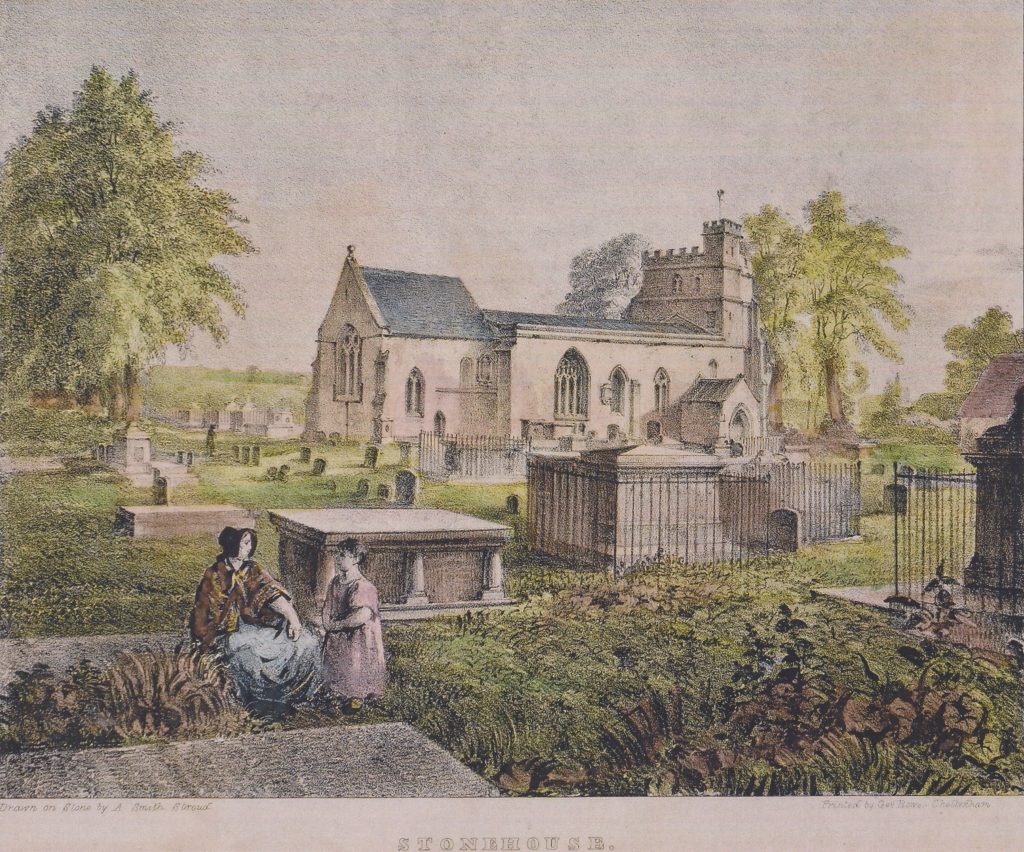
Painting drawn on stone by A Smith of Stroud around 1840 before the church was rebuilt.
1348
Stonehouse Court was part of lands granted first to Sir Maurice Berkeley and then in 1348 to John Maltravers ““by tenure de Marchacia by a rose per annum”.
This mention of a rose may have led to it becoming a symbol of the town.
Floret Floruit Floreat translates as: – It flourishes, it has flourished, it will flourish. This logo was used by the Stonehouse Horticultural Society in Victorian times and has been adopted by the Town.
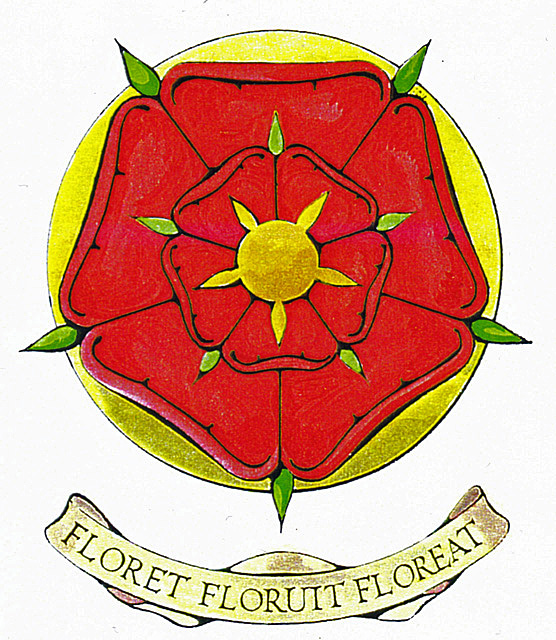
Stonehouse Rose
1600
Two of the oldest buildings still surviving in Stonehouse were built.
The Tudor Cottage in High Street (Tudor Tandoori in 2019)
No 1 High Street also known as Trotman’s Farm, Queen Anne’s Cottage or The Thatched Cottage.
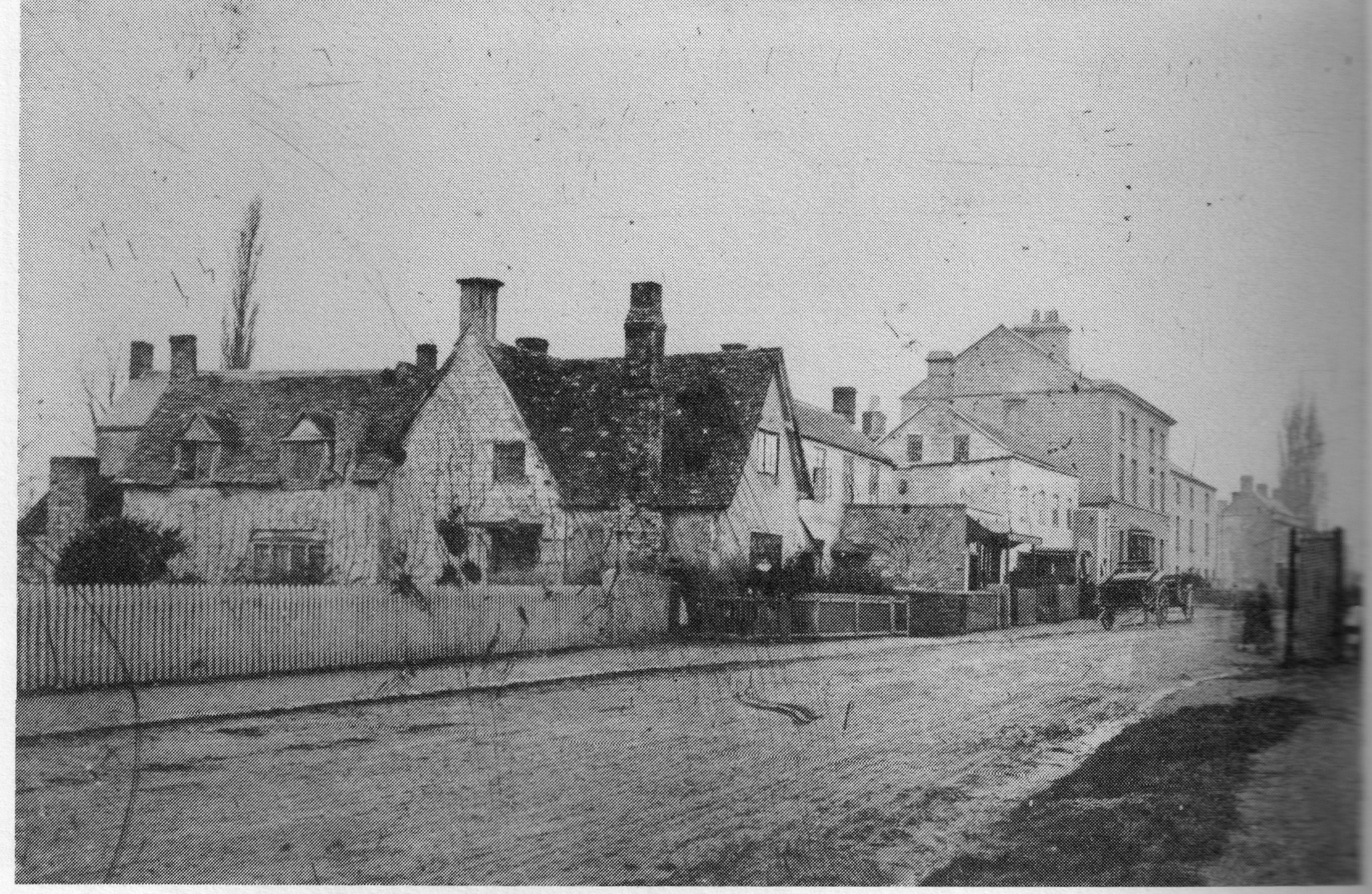
Tudor House 1864
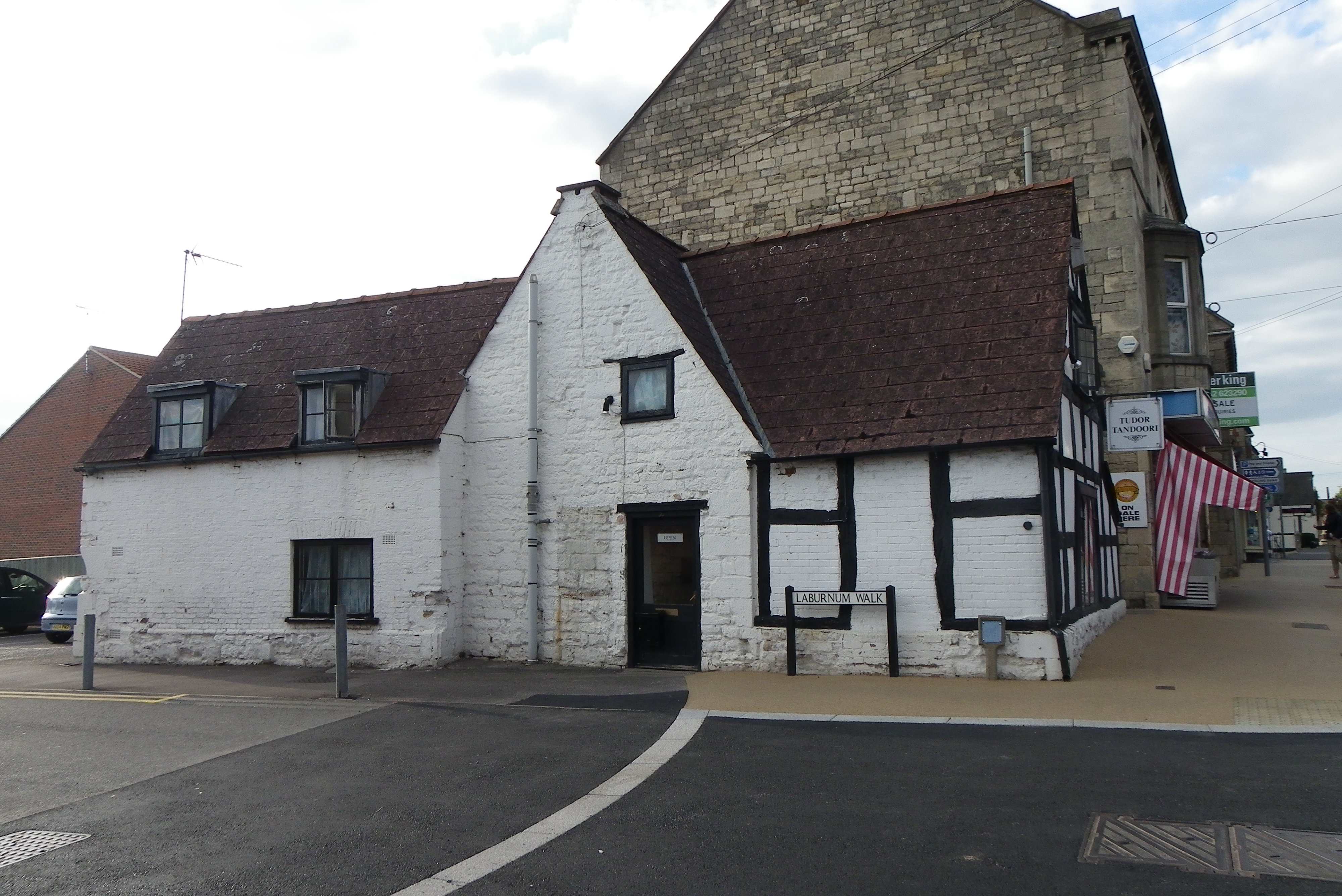
Tudor Cottage 2011
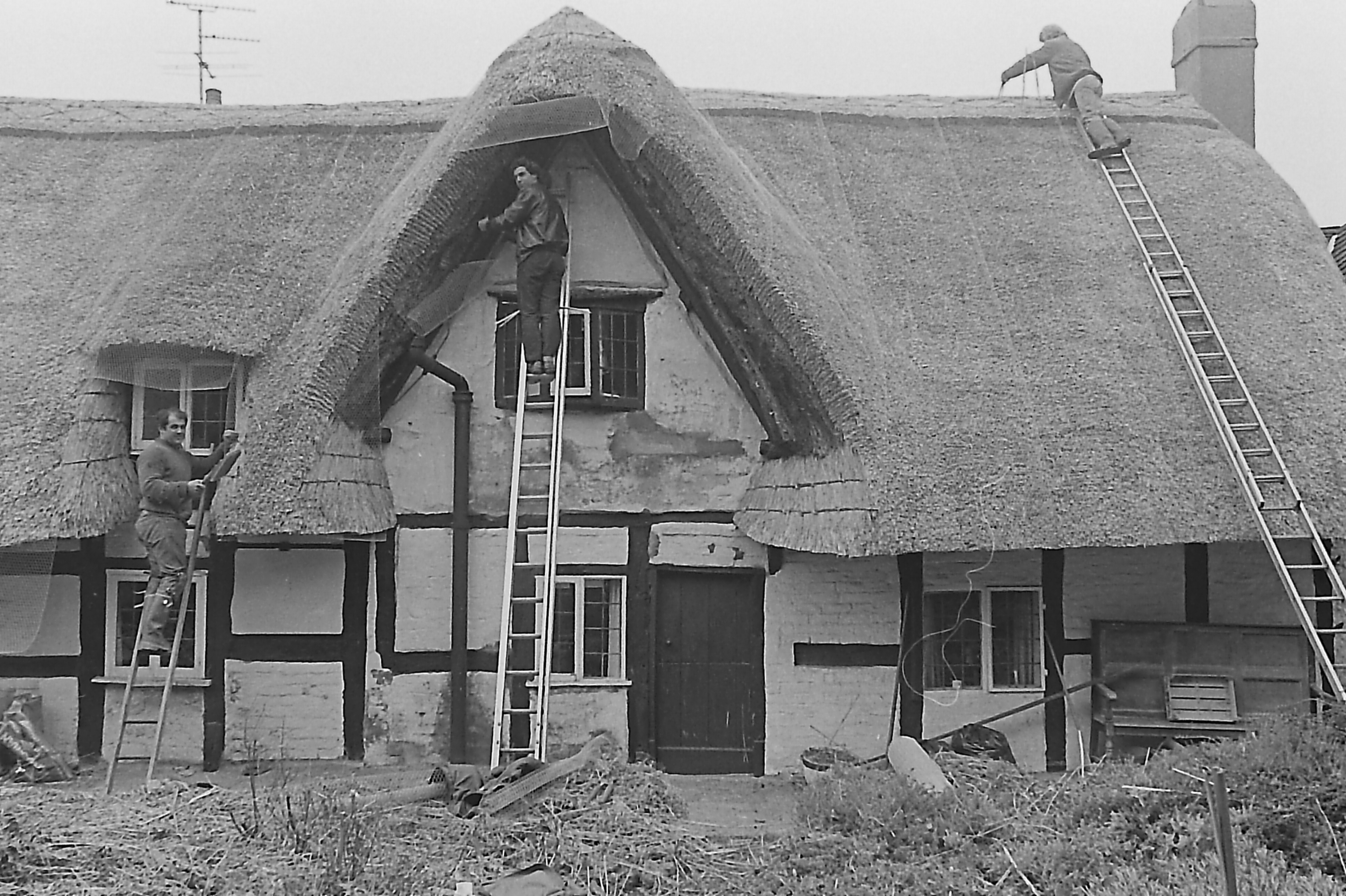
Queen Anne’s cottage being re-thatched
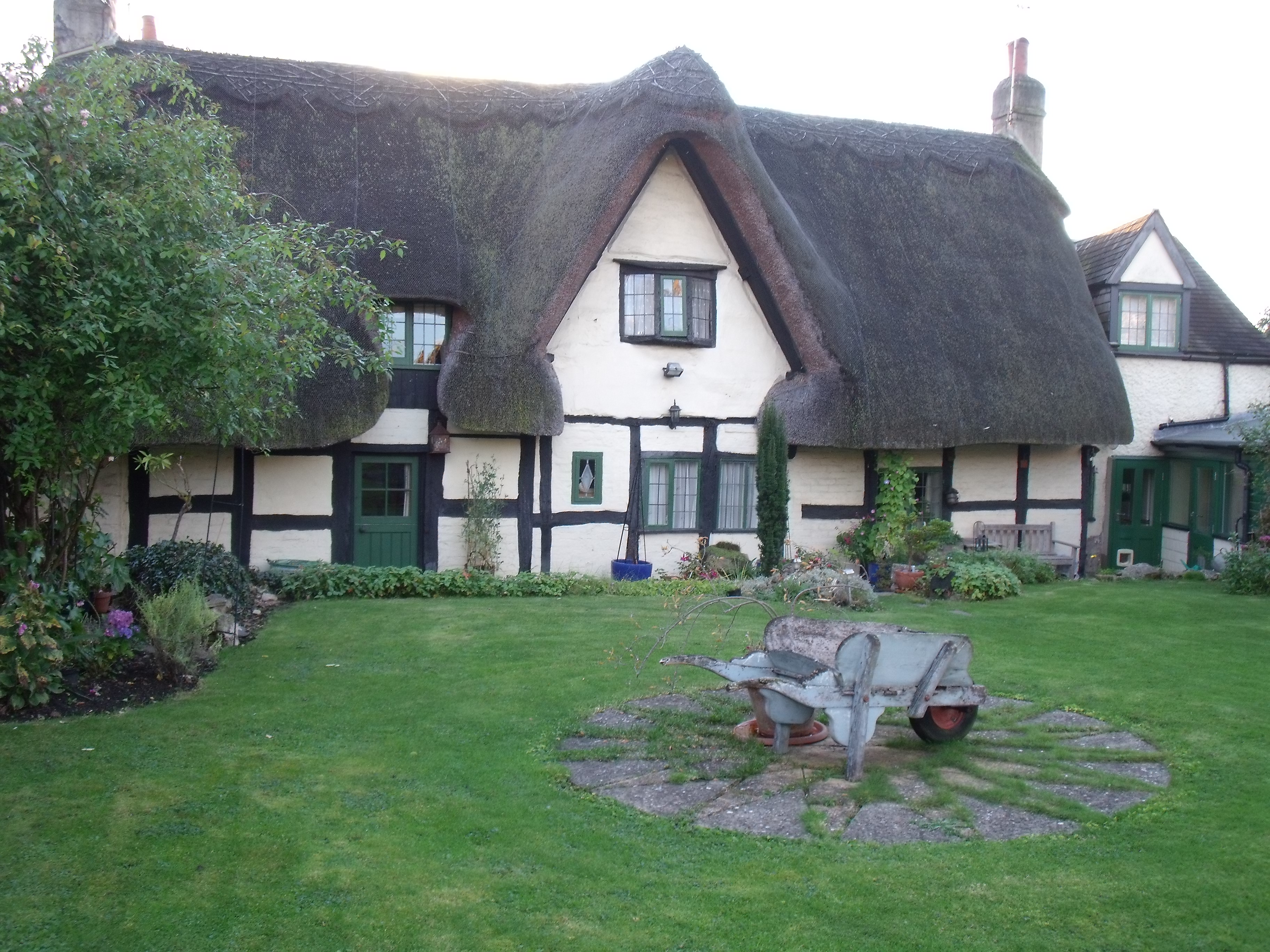
Queen Anne’s cottage No 1 High Street
1601
In 1559 William Sandford and William Fowler bought Stonehouse Court for £1092 16s 2d and in 1568 William Fowler succeeded wholly to the rights and tenements of the Manor. It was William Fowler’s son, Daniel, who rebuilt the house in 1601.
The present building at Stonehouse Court dates from 1601.
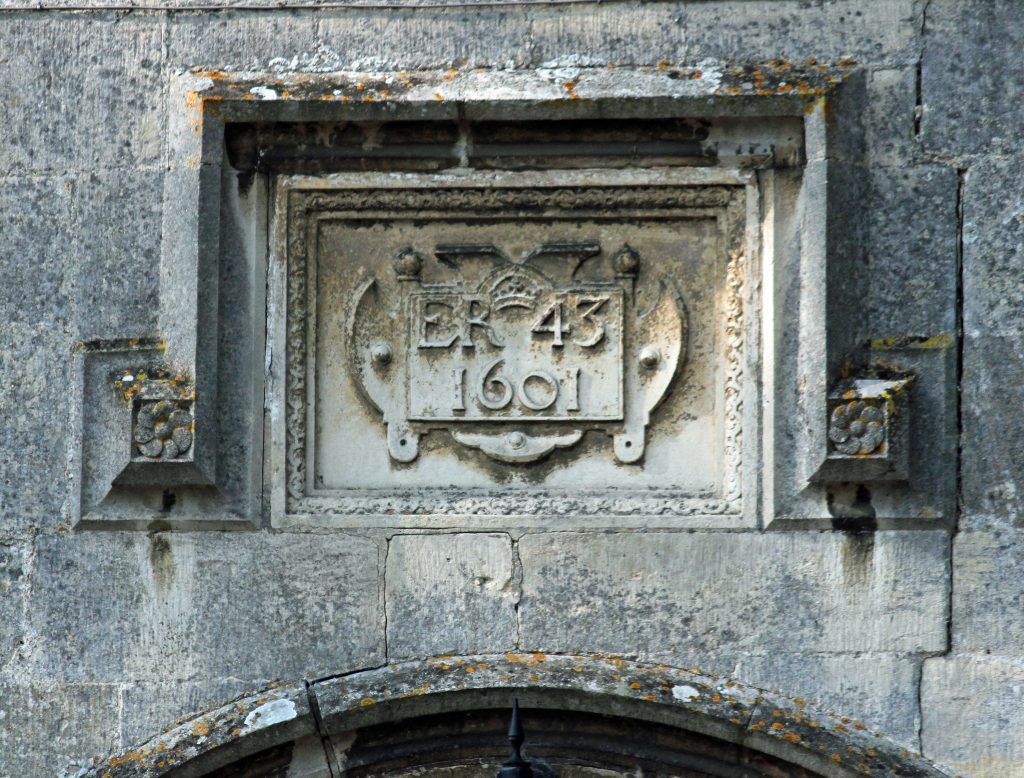
Plaque above the entrance to Stonehouse Court with the date it was built – 1601.
1691
Bridgend House was built in 1691 for William Clutterbuck, a member of the Huguenot clothier family. They had a great influence upon cloth-making which had been an important industry in Stonehouse since the 15th century.
Population of Stonehouse about 500
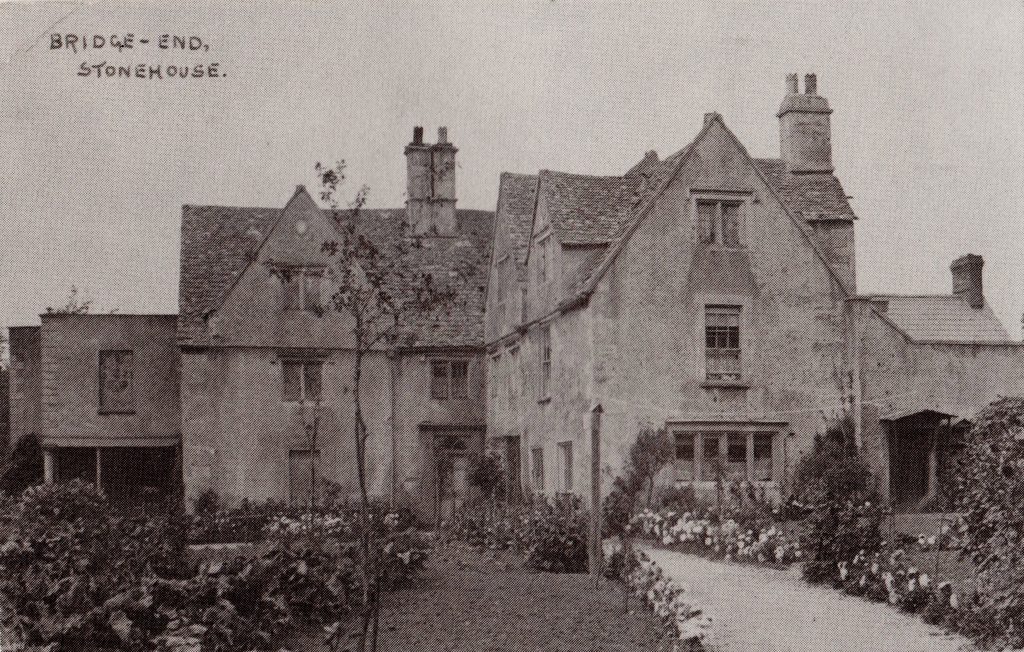
Bridgend House 1691
1737
While Samson Harris was Priest of St Cyr’s, 1727-63, the parish was visited several times by his friend George Whitefield, the Methodist leader. In 1737 Whitefield preached at the church regularly and claimed to have increased the congregation. Whitefield again visited in 1739 and preached in the rain to a crowd, which he estimated at 3,000.
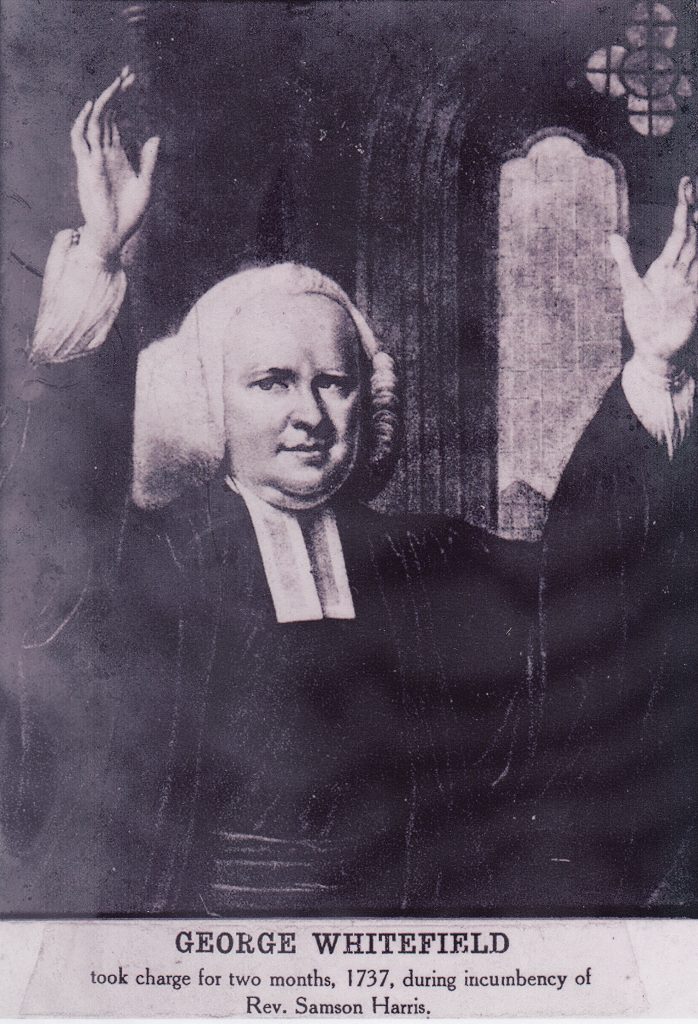
George Whitefield
1775
The Stroudwater Navigation Canal was built between 1775 and 1779.
Its purpose was to link the woollen mills of the Stroud area to the river Severn and to transport goods up and down.
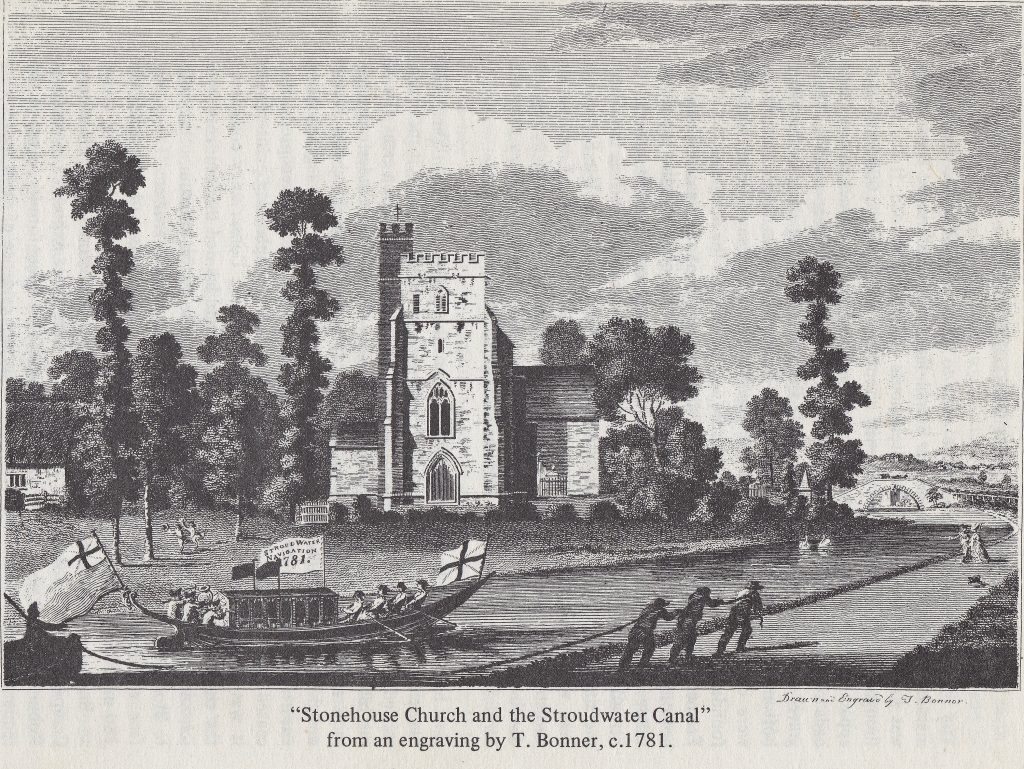
An engraving of a boat being rowed along the Stroudwater Navigation in 1781
1778
Nutshell Bridge was built 1778 (restored in 1988.)
Nutshell Bridge was reopened for canal traffic in 2000.
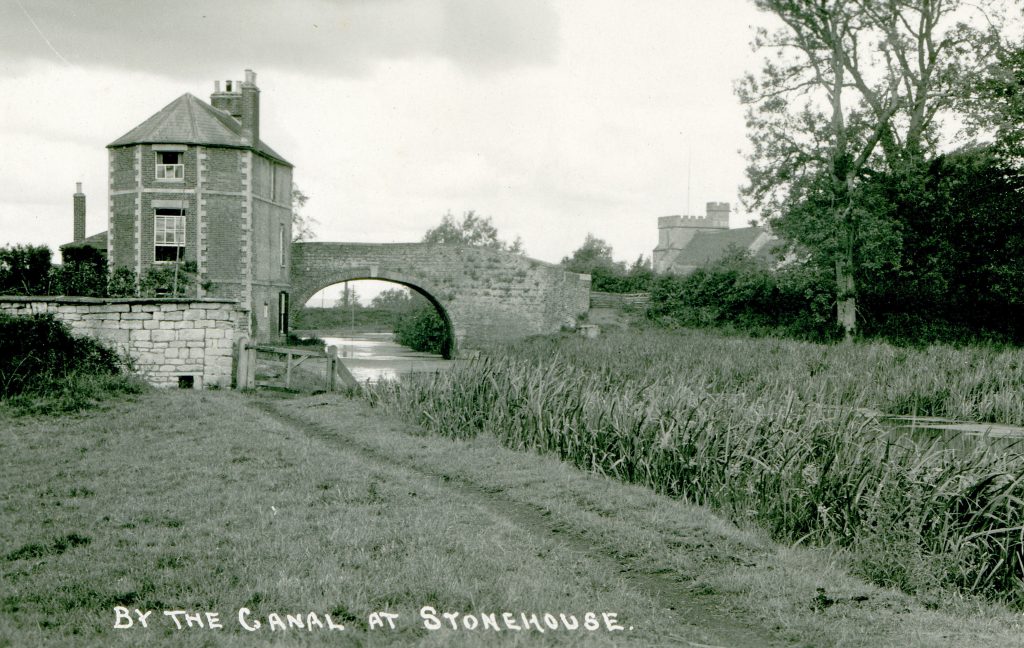
An old photo of Nutshell Bridge featuring a gate across the towpath
1827
Stonehouse Congregational Church in the High Street was built in 1827. The Jubilee entrance arch commemorated the Golden Jubilee of the building.
The church closed in December 1964 and the building was gutted by fire in April 1967.
Population of Stonehouse 1711
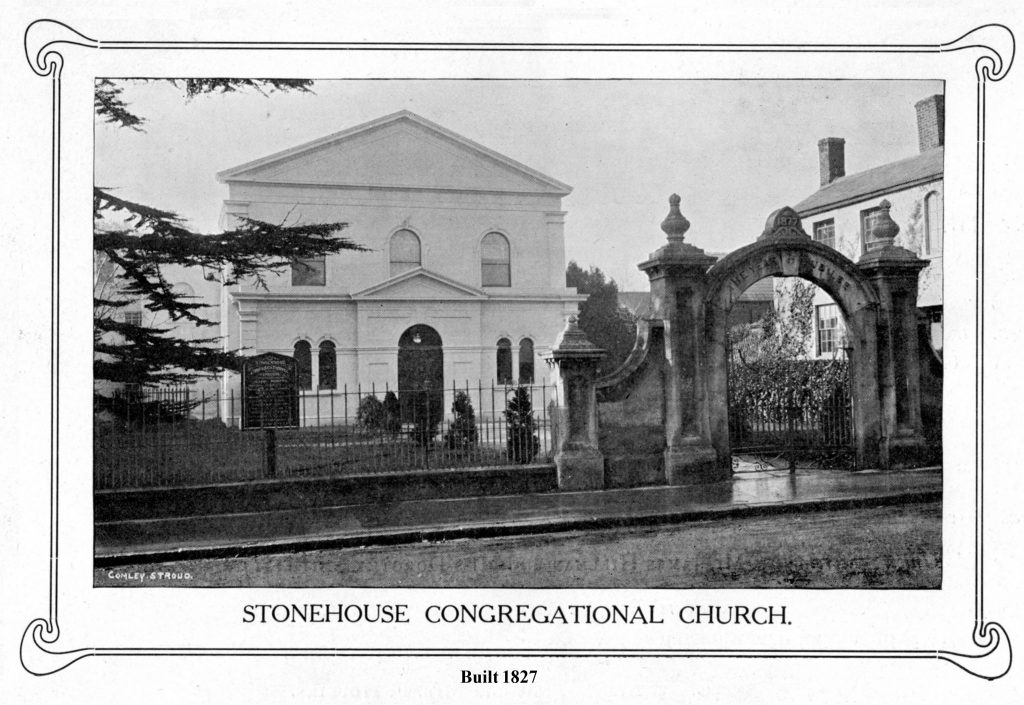
Congregational Church (Chapel) in High Street. Where Wynn’s Cafe is in 2019.
1830
Standish House was built as a shooting lodge for Lord Sherborne.
It was the home of social reformer, Beatrice Webb for more than 20 years.
It became a VAD Red Cross hospital during the First World War, then a Tuberculosis Sanatorium in 1922.
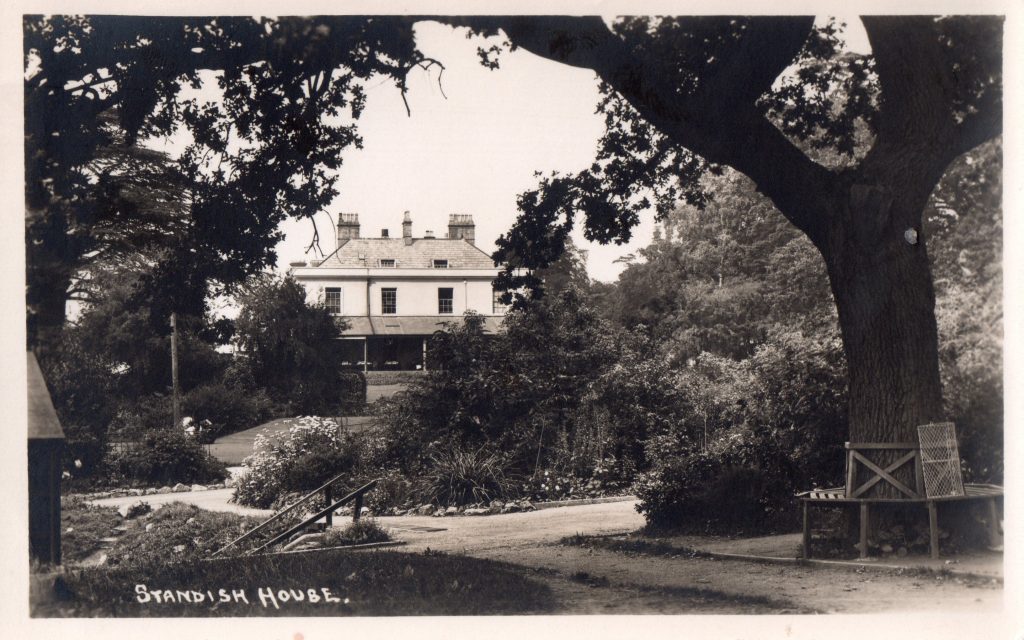
Standish House before it became a hospital.
1832
The National School was built in 1832 and enlarged in 1873.
The old building houses Stonehouse Park Infant School and Children’s Centre. New buildings have been added to enlarge the Infant School
The Park Junior School was built in 1985 in the field opposite.
Population of Stonehouse 2469
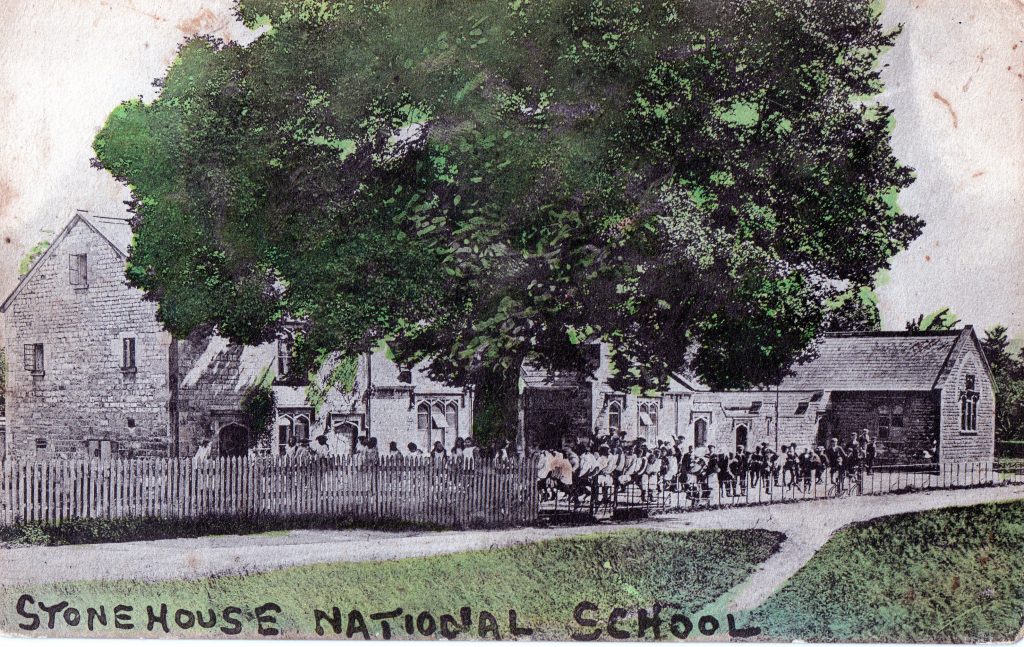
Stonehouse National School
1844
The railway which became the London Midland Scottish (LMS) line was opened through the western edge of Stonehouse in 1844 and the Bristol Road station was opened on 8 July 1944.
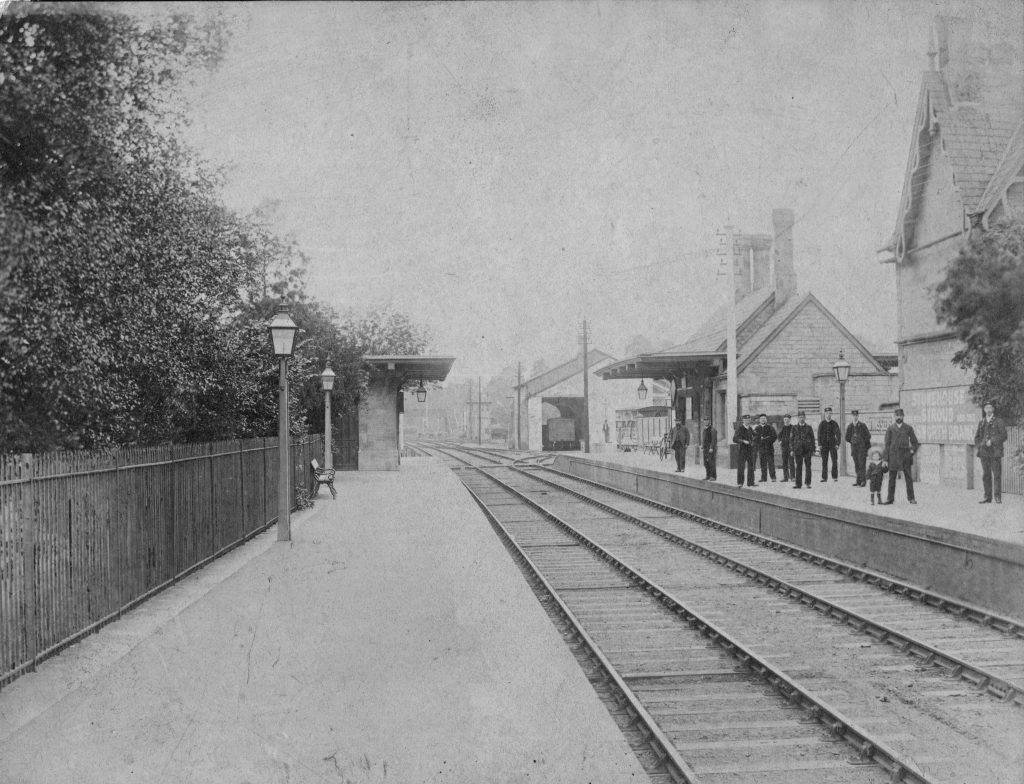
Bristol Road railway station
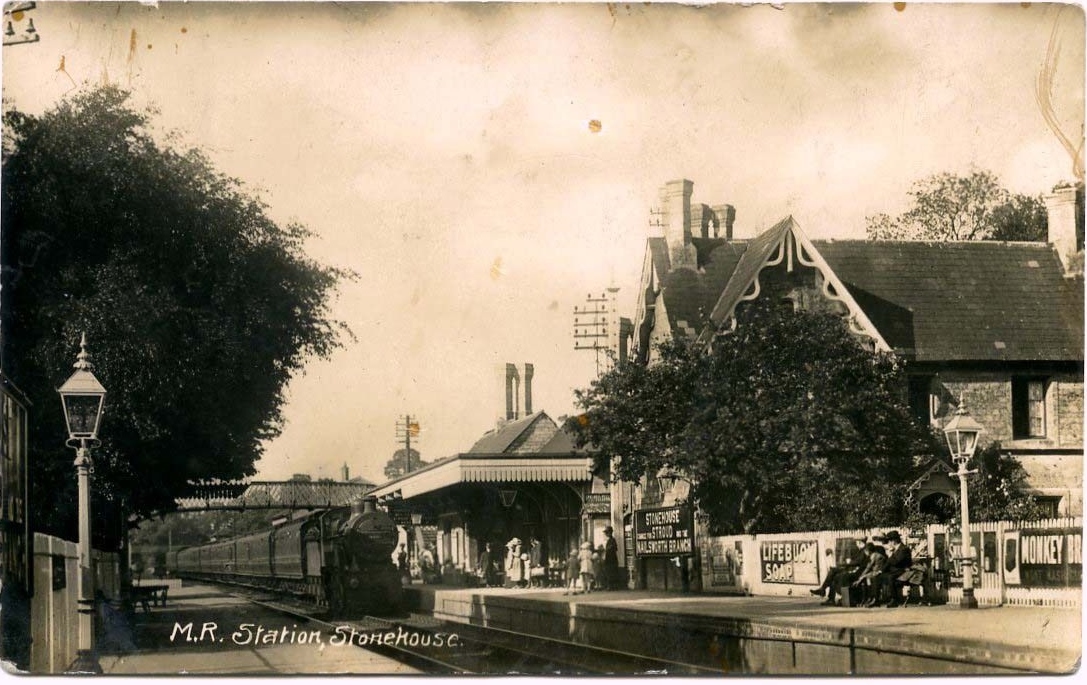
Midland Railway Station
1845
The Great Western Railway was designed and built by Isambard Kingdom Brunel. The first train passed through Stonehouse Station (now called Burdett Road Station) from Swindon to Gloucester on April 14th 1845.
The coming of the railways heralded a time of growth for Stonehouse with many large new houses being built near the station.
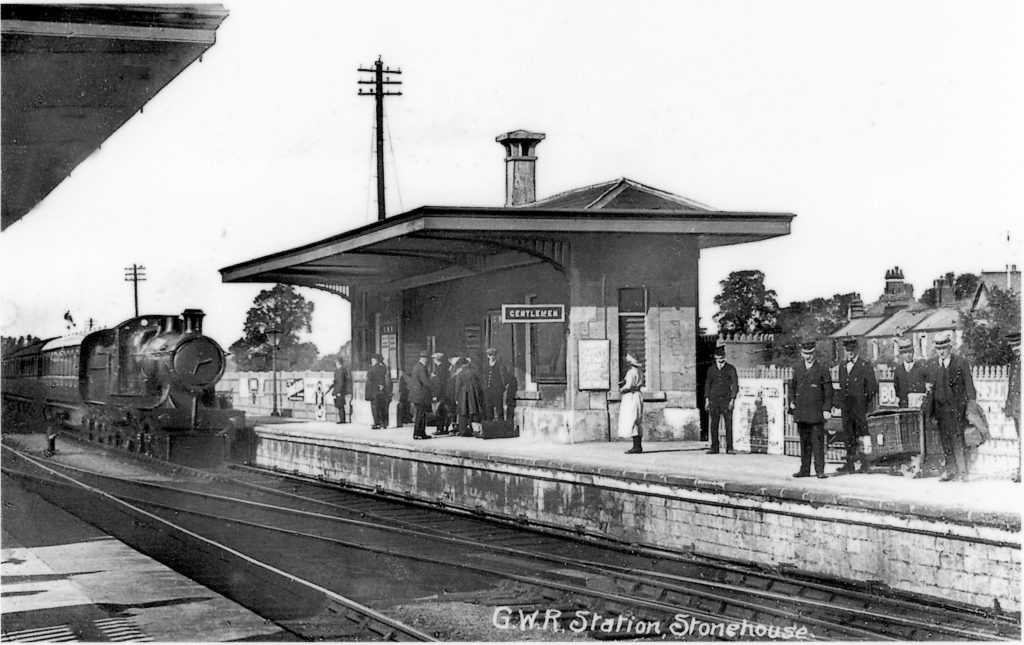
Stonehouse GWR Station (now Burdett Road Station) c1920
1864
The building of the Stonehouse to Nailsworth Railway was started in 1864, the first sod was cut in Nailsworth with great ceremony on Monday February 22nd 1864.
This was a branch line of the Midland Railway which ran from the Midlands through Stonehouse to Bristol. The branch line ran from Stonehouse through Ryeford, Dudbridge and Stroud to Nailsworth. It opened in 1867.
It closed to passengers in 1947 and to freight in 1966.
The cycle path along the side of the Ebley bypass now runs along its old route.
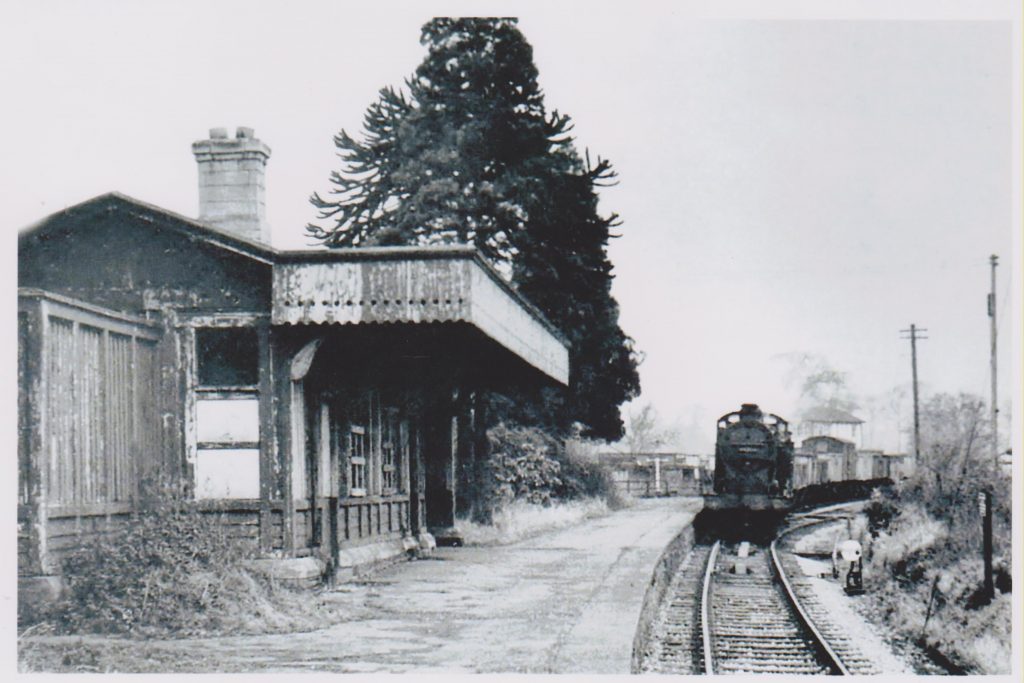
The station off Bristol Road Railway Station for the Nailsworth branch line.
1882
Wycliffe College was founded in 1882.
On the 6th April 1881, Haywardsfield Hall was purchased by George William Sibly for £2,990, to become Wycliffe College.
Sibly remarked that he chose Stonehouse because it was served by three railway stations.
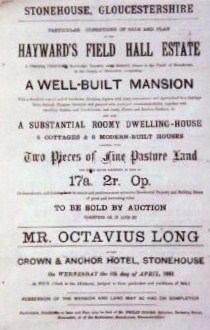
Sale poster for Haywardsfield Hall 1881
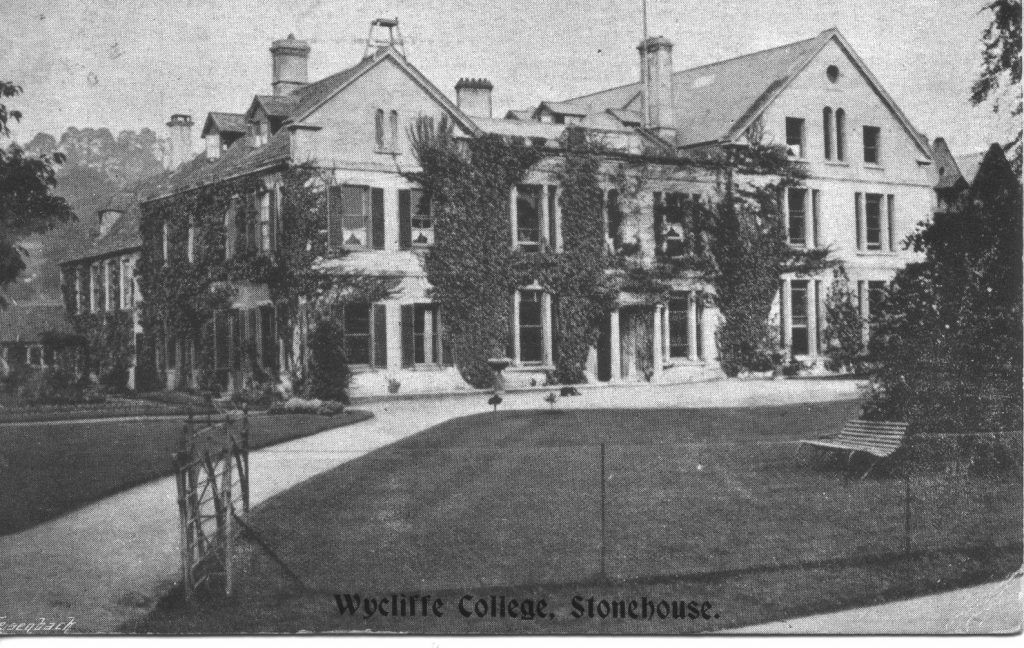
Wycliffe College c1900
1891
Stonehouse Brick and Tile company was founded in 1891. Many buildings were made from Stonehouse brick including the Post Office in 1933.
The 202 ft high chimney was built in 1900 and demolished in 1965.
Population of Stonehouse 4352.
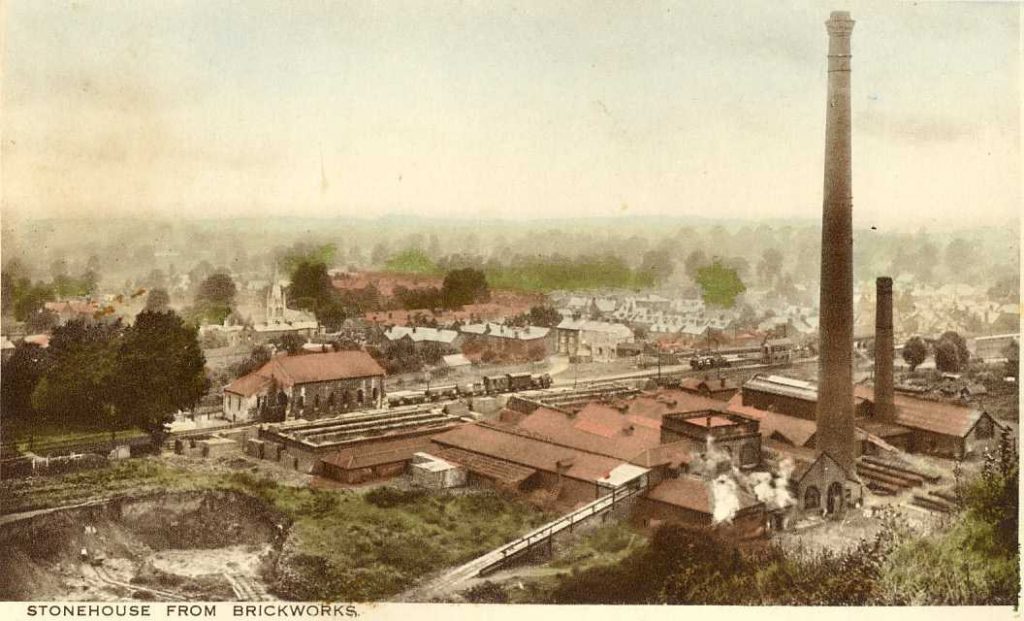
Stonehouse Brick and Tile Co Ltd from Doverow Hill
1895
The first Stonehouse Parish Council meeting took place on January 4th 1895.
In 1898 the council took charge of the greens. They took the Globe Inn to court following conflict over ownership of the green – and won.
The Globe Inn was required to pay 6d per year to erect their signpost on the green. No fairs, stalls etc to be erected without the permission of the Council.
In 1894 Cainscross was removed from the Parish and the population halved until 1930s. Population approx. 2300.
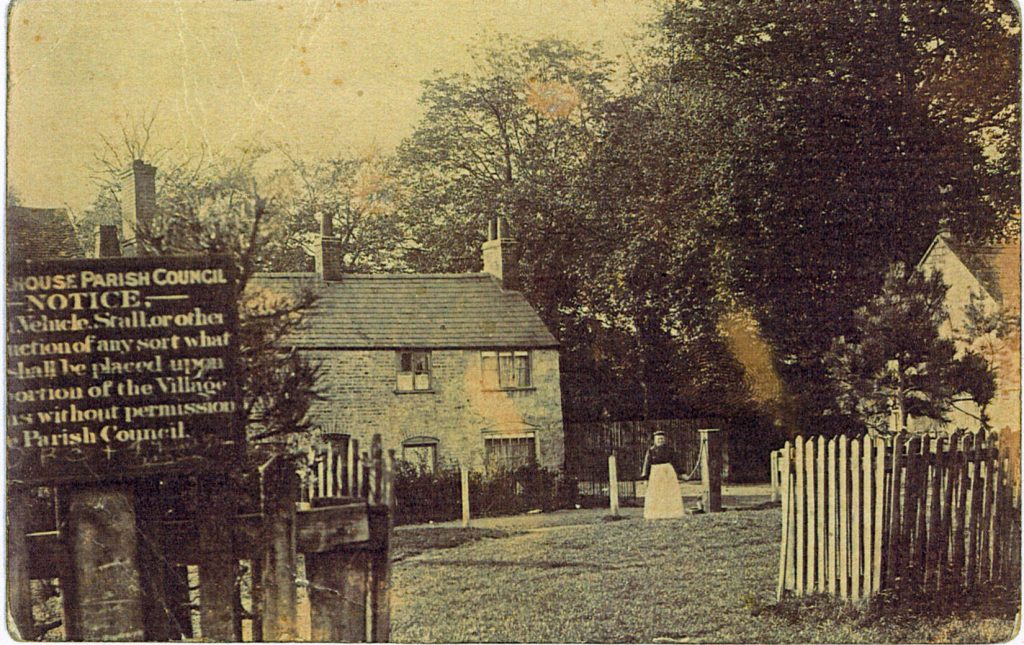
The village Green with Council notice c1898
1911
The foundation stone for Wycliffe Chapel was laid in May 1911.
It was shared by the school and the Methodist church.
The Chapel, which cost £2300, was opened on 19th October 1911.
The chapel was severely damaged by fire in November 1939 and was rebuilt with participation of the schoolboys in the 1950s.
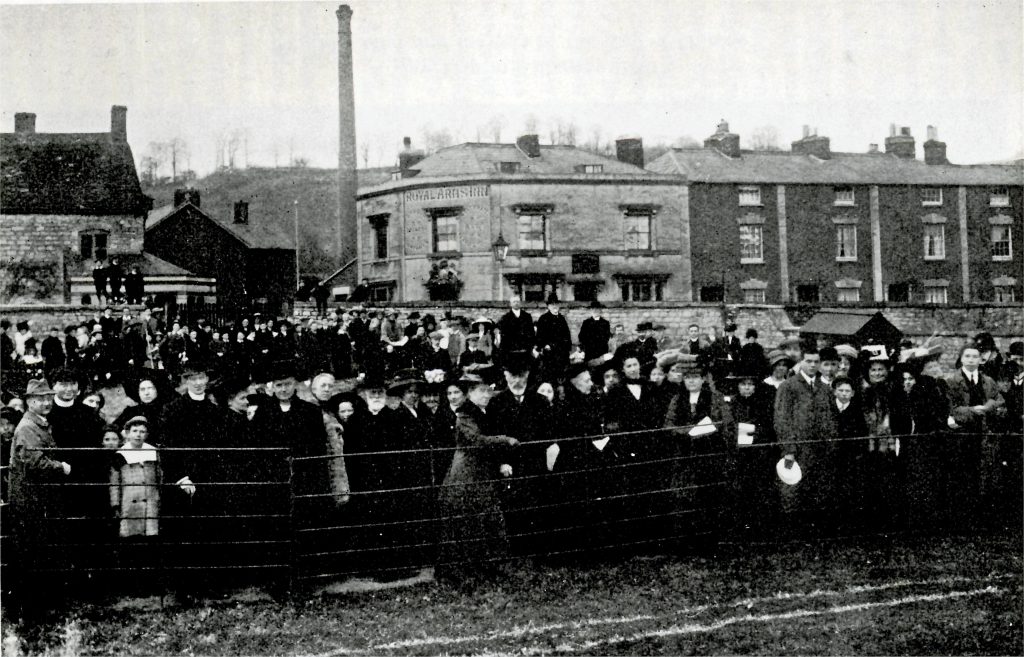
Wycliffe Chapel 1911
1914
The Cattle Trough was presented to the Stonehouse Parish Council by the Band of Mercy in September 1914. It became known as the Horse Trough.
It was located at the junction of Bath Road and Bristol Road. In the early 1990s it was moved to the opposite side of Bath Road when the new Horsetrough Roundabout was built for the Ebley Bypass.
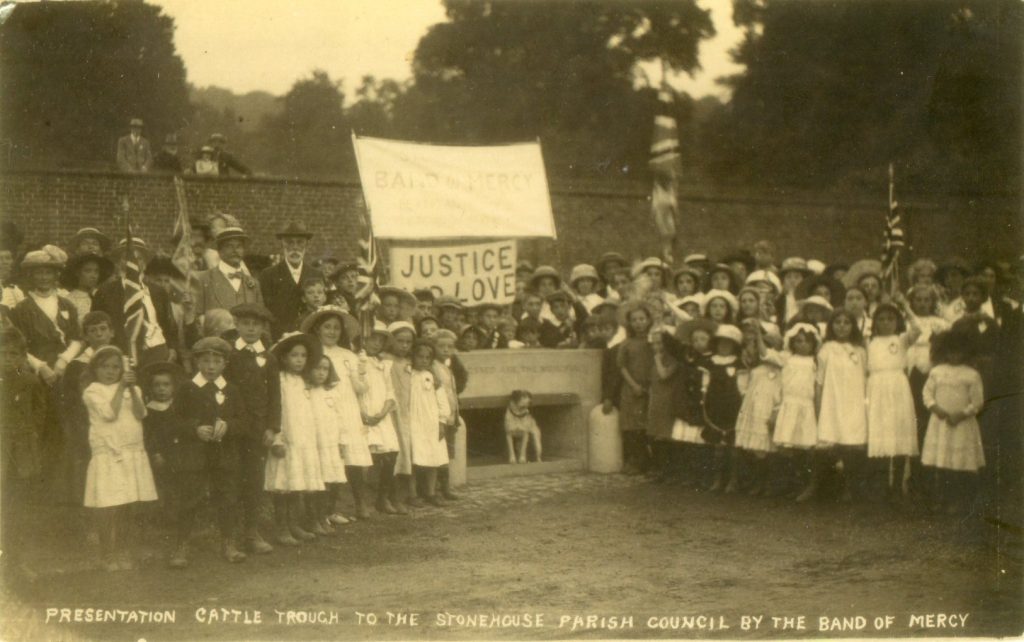
Cattle trough presentation
1919
In memory of the men who fell in the Great War, the War Memorial Cross was unveiled on the green by Miss Emily Davies, and dedicated by the Rev. R. P. Waugh, August 12, 1919. The ceremony was attended by a large crowd.
Later the stone carved names were replaced by brass plaques and the names of those who died in WW2 added.
The Memorial was refurbished in the summer of 2009 which made it look as good as it did in 1919.
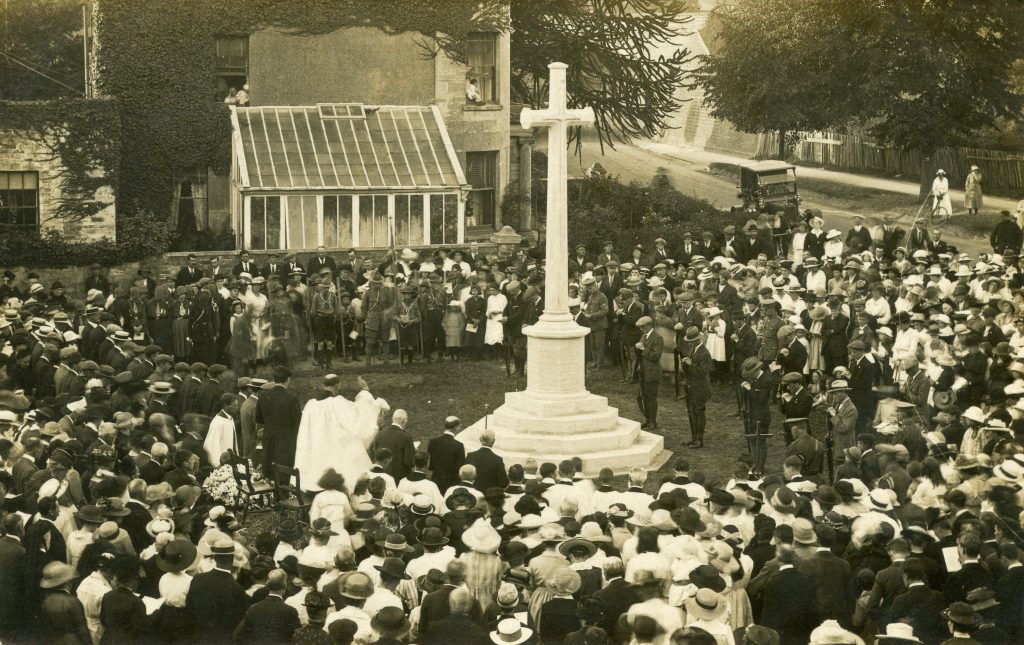
War memorial August 1919
1921
Willow Tree Green was purchased for the town and the willow tree planted.
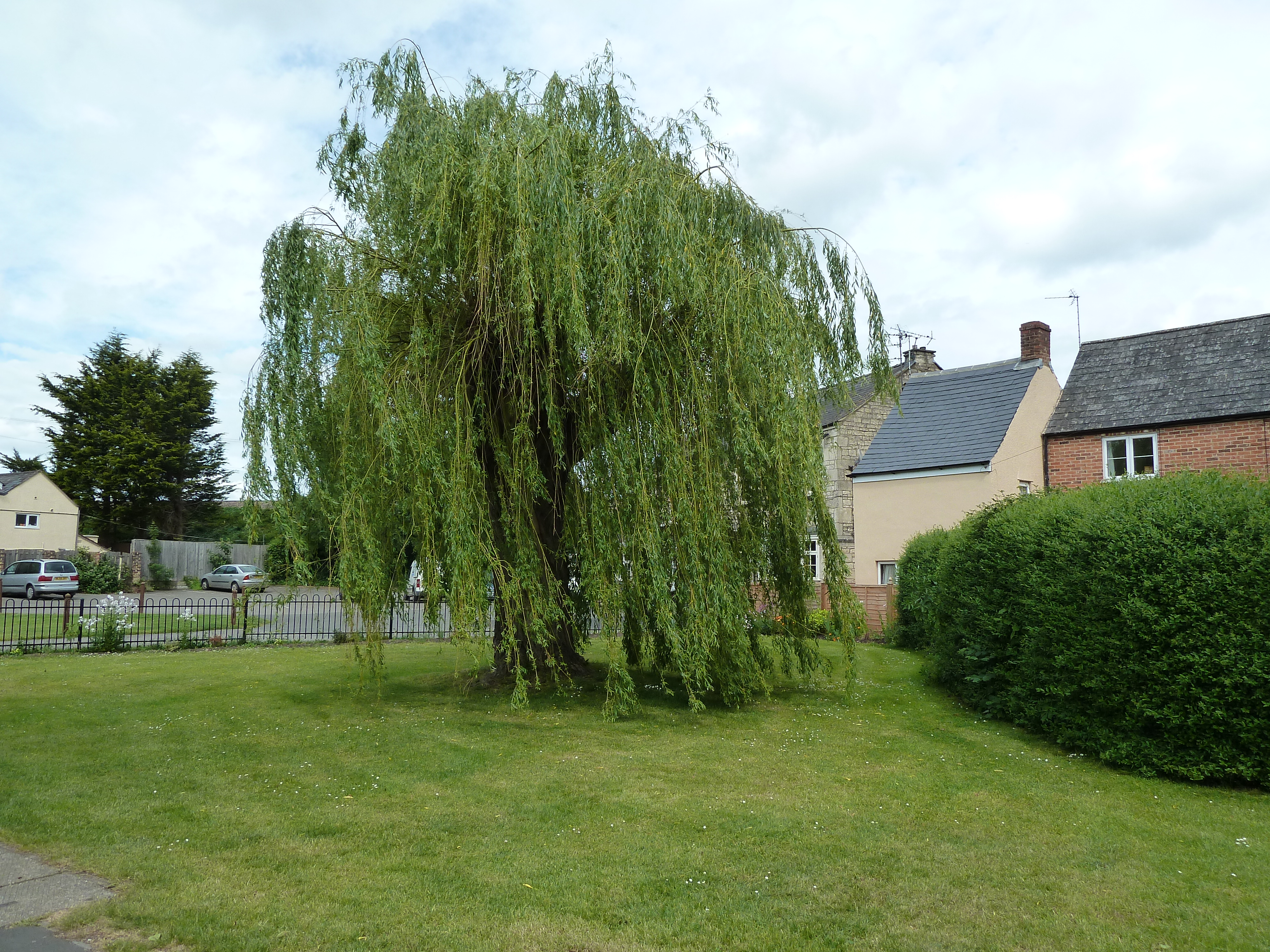
The willow tree in May 2019
1921
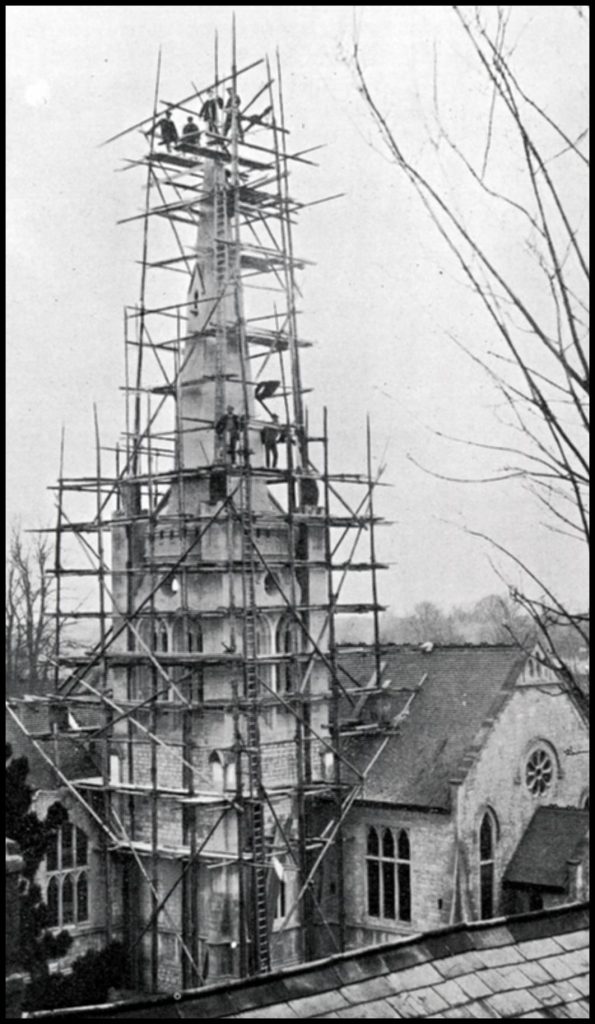
Wycliffe Chapel clock tower and spire were added to the chapel in 1921, ten years after the chapel was built, in memory of Old Wycliffians who gave their lives in the Great War.
1927
The Parish Council considered electric street lighting but decided to stay with gas street lamps. Electric street lighting came in 1951 but was not complete until c1960.
By 1930 the SE part of town was supplied with electricity and the rest of the town by the early 1940s.
Population of Stonehouse about 2300
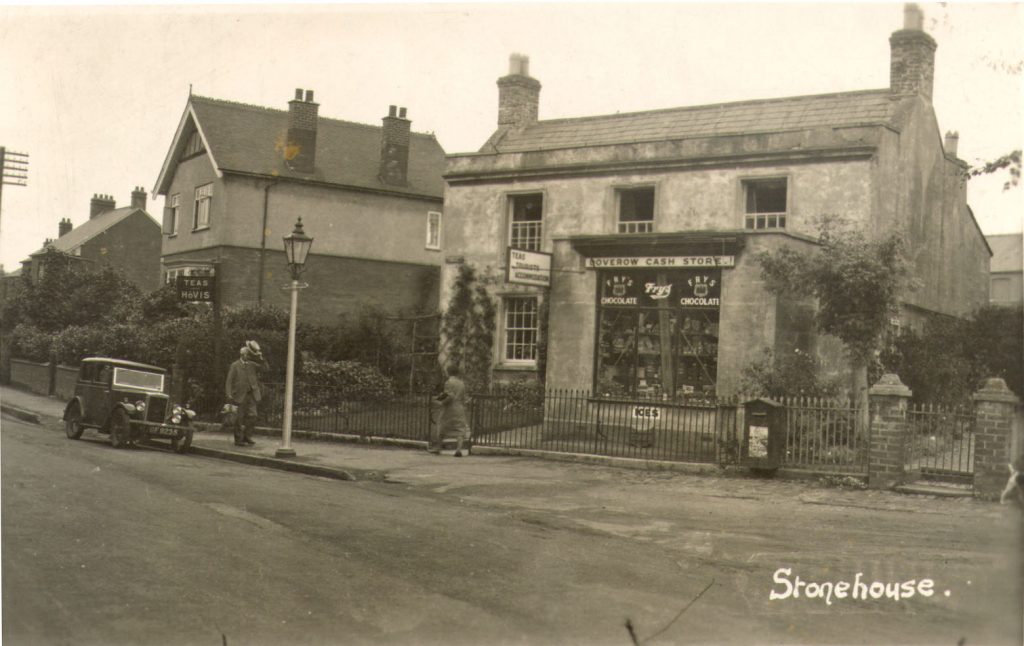
Doverow Cash Stores at the bottom of Pearcroft Road c1930s, showing street lamp.
1933
The Post Office in Queens Road was built in 1933. The opening ceremony on 2nd November 1933 was performed by Sir Stephen Tallents, Public Relations Officer to the General Post Office.
It was noted that the building was erected for Stonehouse people by a Stonehouse firm, (A. R. Blick & Son), using Stonehouse bricks
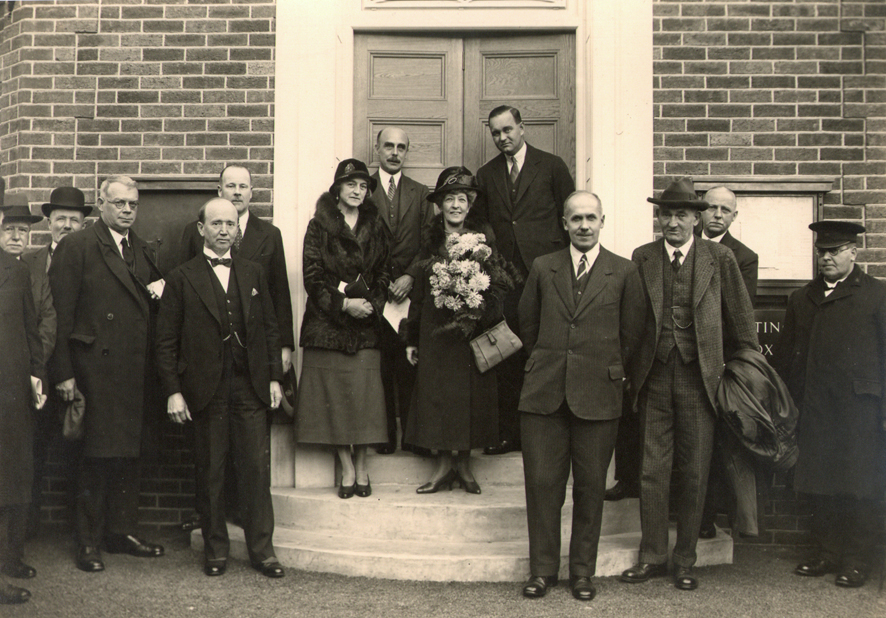
Stonehouse Post Office opening Nov 2nd 1933 Guests on steps
Guests at the opening of the new Post Office
Central figures include Captain Ben Parkin (Chairman of Stonehouse Parish Council), Mr C.A. Jackson (GPO Surveyor), Mr Leo Blick (Builder), Mrs Caroline Winterbotham, Sir Stephen Tallents (Public Relations Officer to the GPO), Lady Marling, Mr Robert Perkins (Stroud MP), Mr W.A. Sibly (Headmaster of Wycliffe College), Mr A.S. Winterbotham (Lord of Stonehouse Manor, living at Stonehouse Court)
Gentlemen at the edges of the photograph may be Capt. F. G. Lee (Postmaster at Stonehouse),
Mr. H. D. Macdonald (Head Postmaster at Stroud), Mr Hill and Mr Foxworthy (Post Office staff)
1935
The Wycliffe road bridge at Ryeford was opened in 1935. The bridge was given to the school by Mr Hubert Batchelar in memory of his wife and father-in-law.
Wycliffe teacher, Arthur French, was responsible for the original drawing of the Wycliffe crest which adorns the bridge.
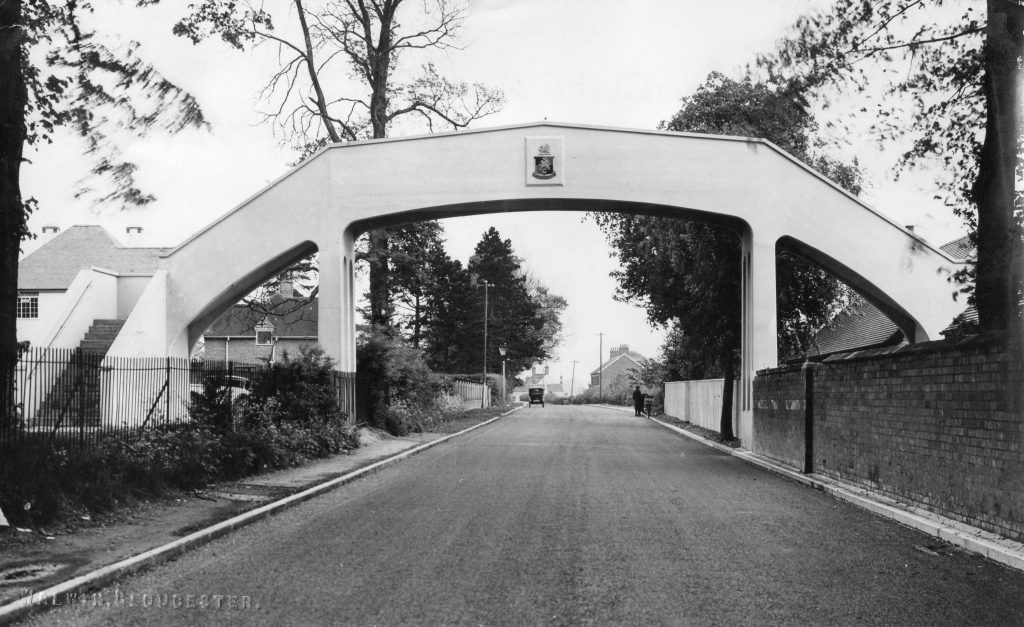
1937
The Regal Cinema in Gloucester Road was built in 1937. It replaced the old Regal in Laburnum Walk, which burnt down.
The Regal was closed in 1959 and converted to a panel beating factory not long after.
When that business closed in the late 1980s, the building was demolished and Bridge Garage was built.
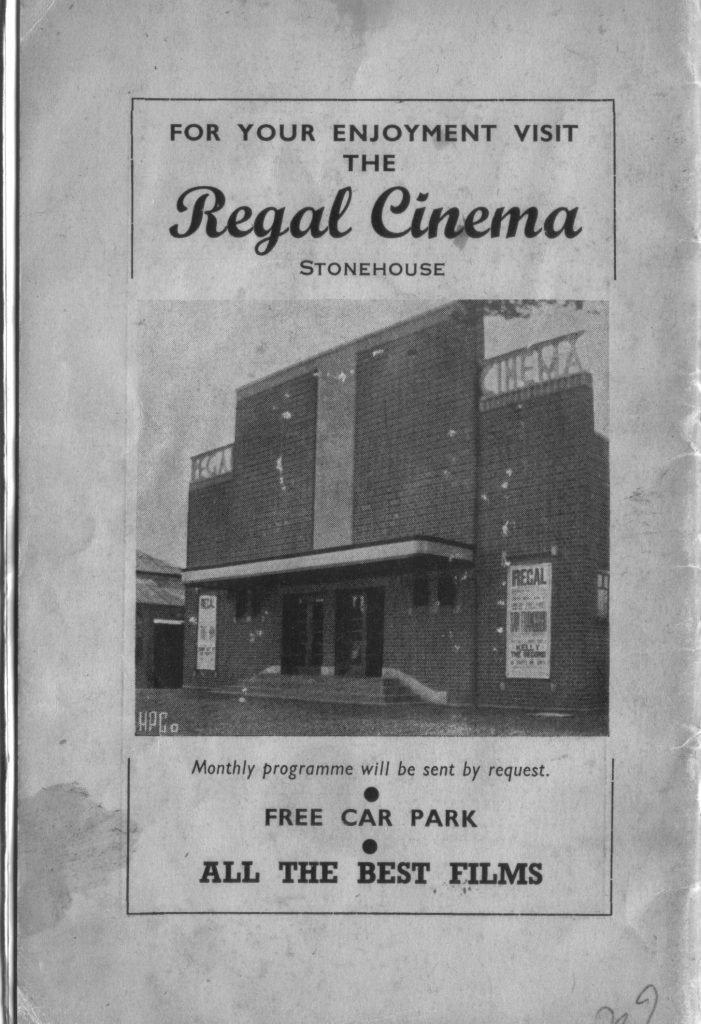
An advert for the Regal Cinema
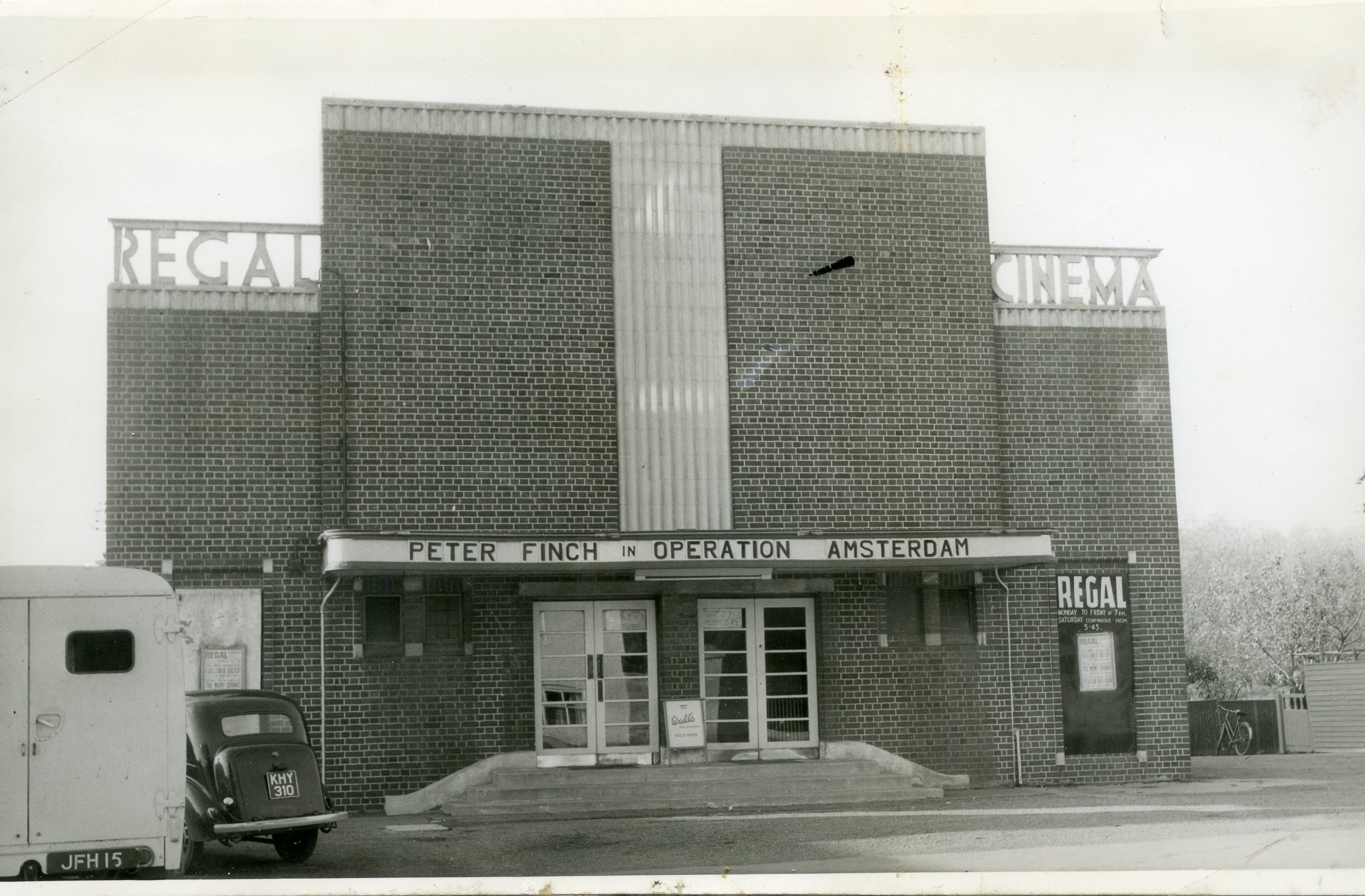
The Regal Cinema 1950s
1938
The “Shadow Factories” came to Stonehouse in 1938, as part of the preparation for the Second World War. Sperry’s Gyroscope Company moved to Bond’s Mill from their factory in Brentford to avoid air attacks. The Bond’s Mill factory was engaged in the manufacture of gyrocompasses, altimeters and other instruments for aircraft, and searchlight systems.
In 1939/40, a new factory was built for Hoffmann’s Bearings at the Bristol Road end of Oldends Lane. They produced large numbers of roller and ball bearings for military purposes. Many of the workers came from the parent factory at Chelmsford and stayed on in Stonehouse after the war.
The population increased dramatically, and by 1951 was 4232.
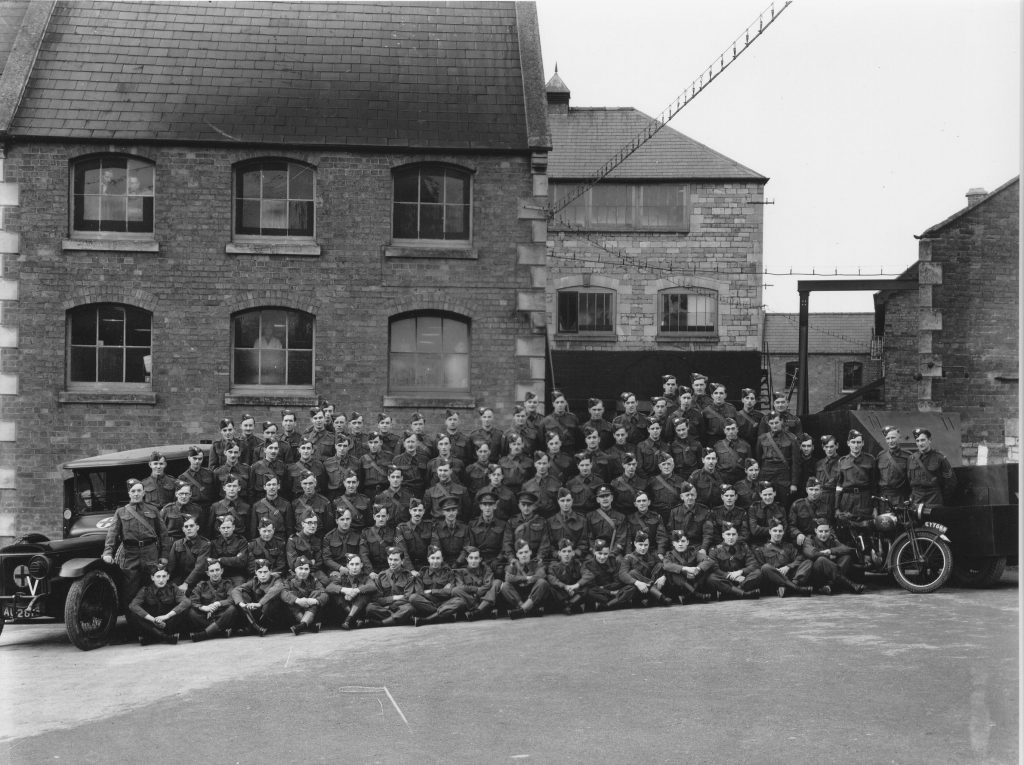
Sperry Gyroscope Home Guard
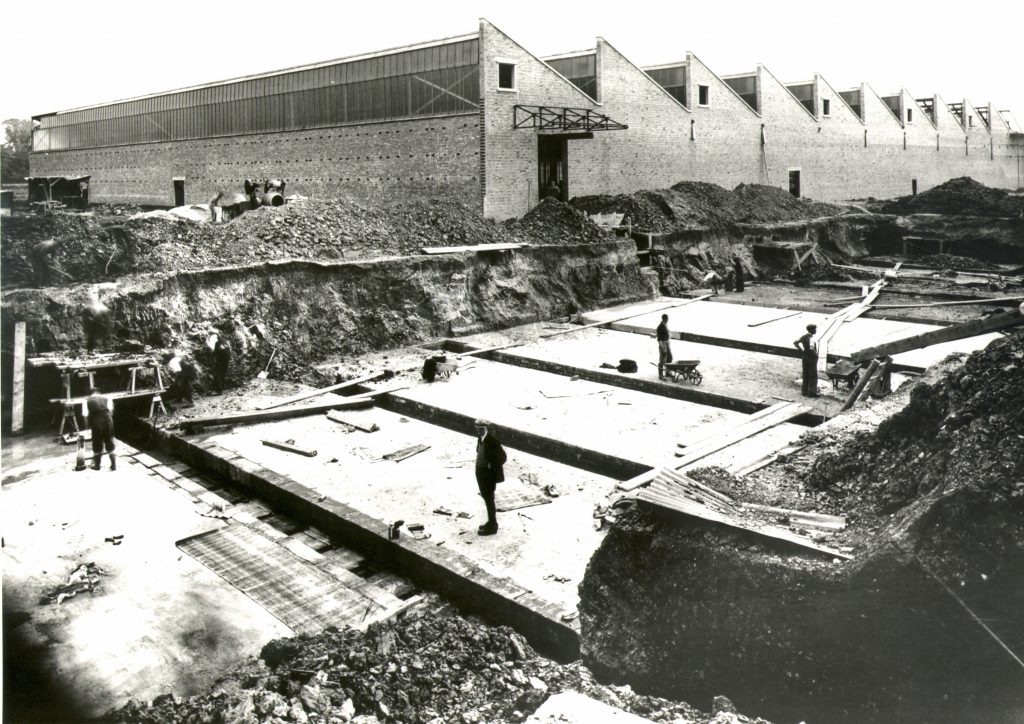
Hoffmann’s construction May 1940
1951
The Park Estate of council houses was started in 1951 to cater for a growing population after the war. Midland Road, Severn Road, Park Road and later Festival Road. It was named after the Manor Park upon which the houses were built.
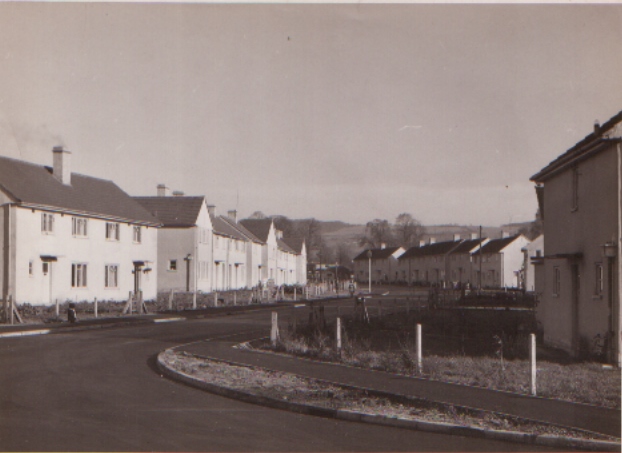
Park Road turning into Festival Road 1950s
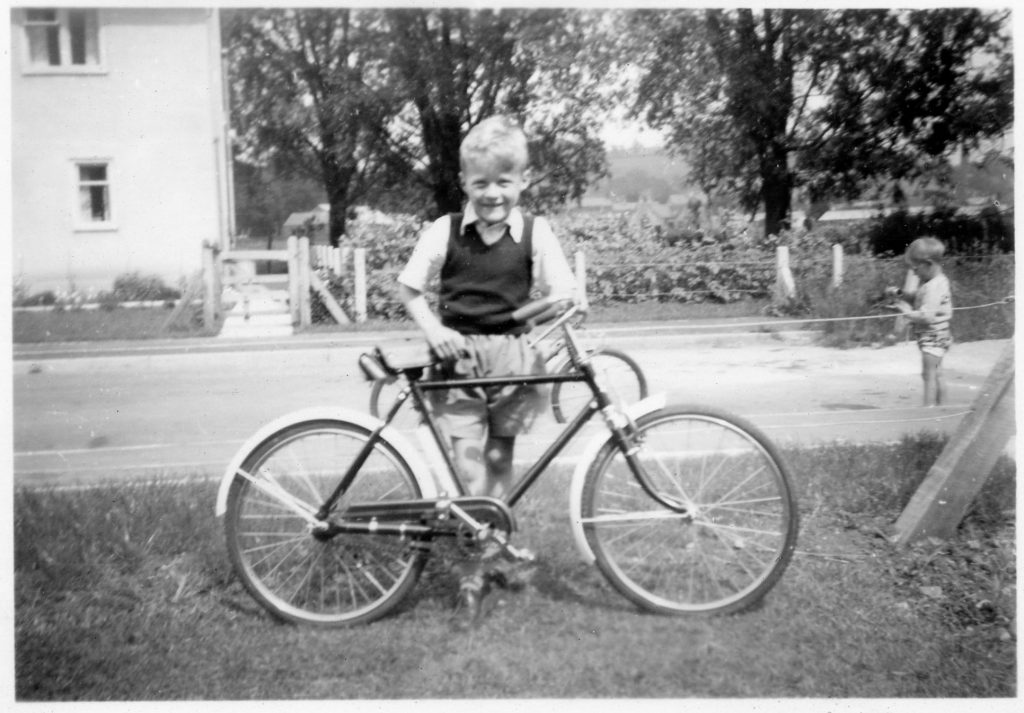
Andrew Walker outside 5 Festival Road c1957
1957
Stonehouse Secondary Modern School opened in King’s Road. It was a state of the art school offering a wide range of practical subjects.
It later became Maidenhill Comprehensive School.
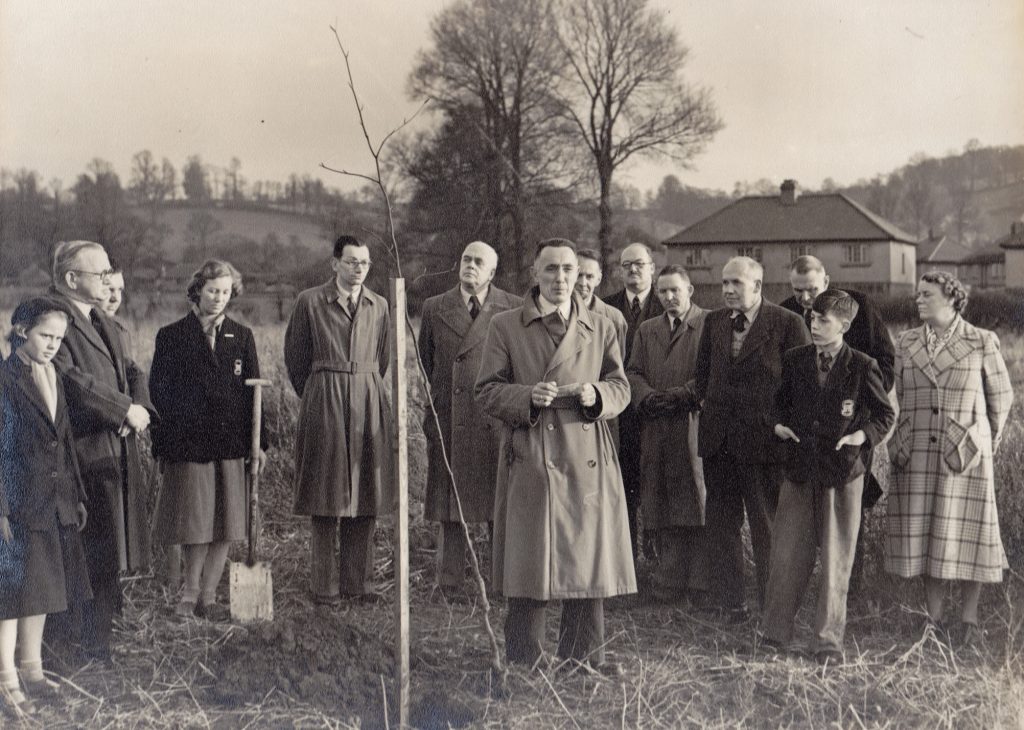
Tree planting to mark the start of building the new secondary school in December 1953
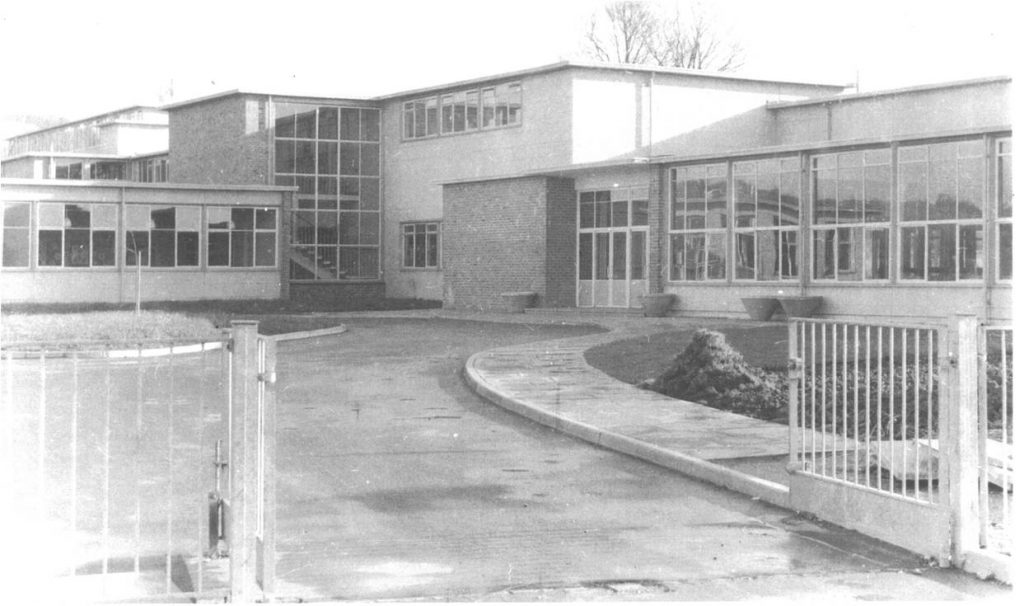
Stonehouse Secondary Modern School 1957
1971
The 6.3 miles of the Moreton Valance Section of the M5 commenced June 1969, completed in March 1971 at a cost of £5.5 million.
There were two interchanges on the section, an elevated roundabout at Stroudwater, and with the A419, where only South facing slip roads were provided.
The disused Stroudwater canal was filled in adjacent to the interchange.
Population of Stonehouse 5455
1987
Elgin Lodge was demolished in 1987 to make way for the new Elgin Mall shopping complex.
When Elgin Mall first opened there was a cafe and many shops including a sports shop, a picture framing shop and a card shop.
in 2022 there are only two shops, the rest is housing.
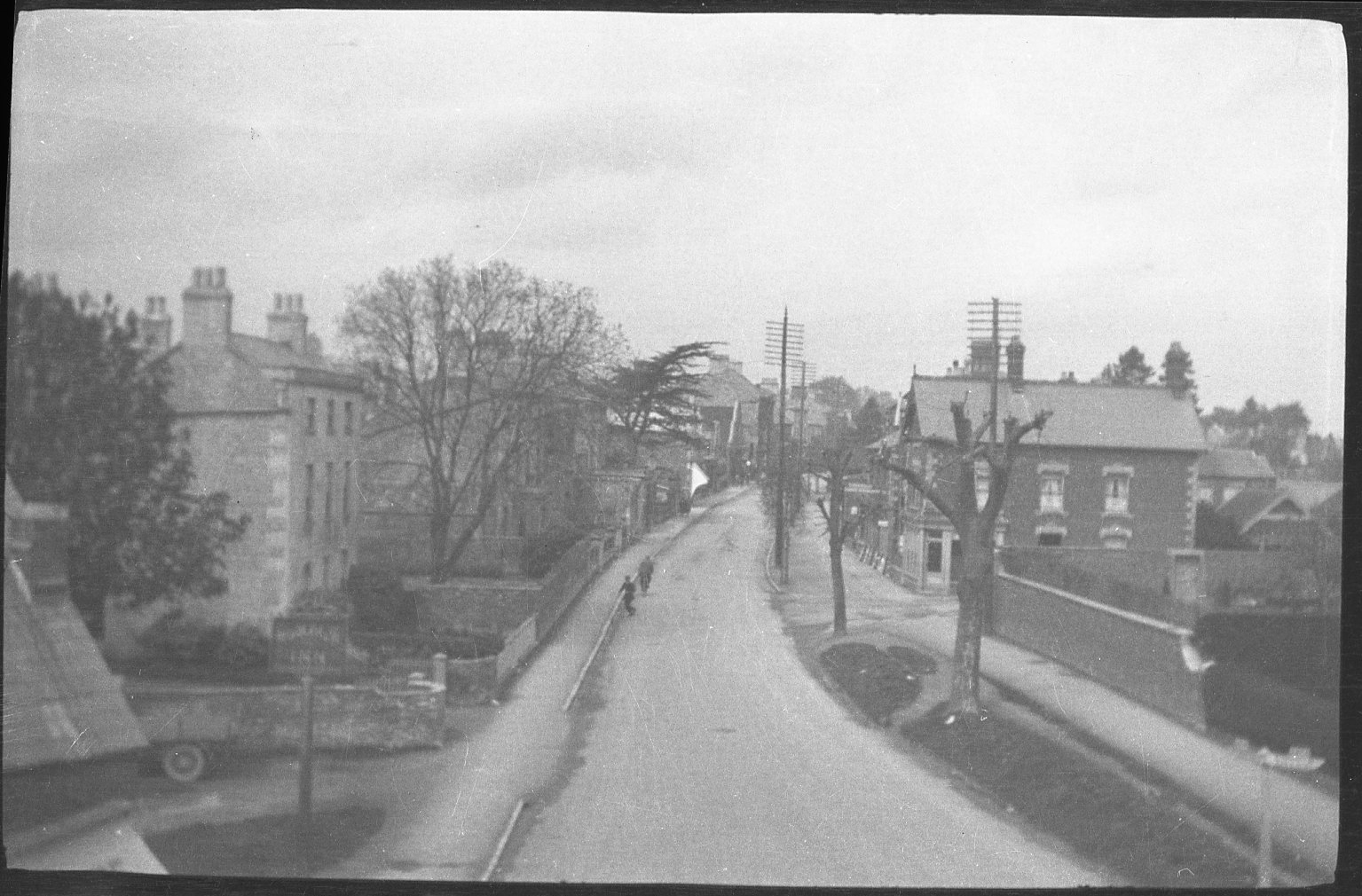
Elgin Lodge 1920s
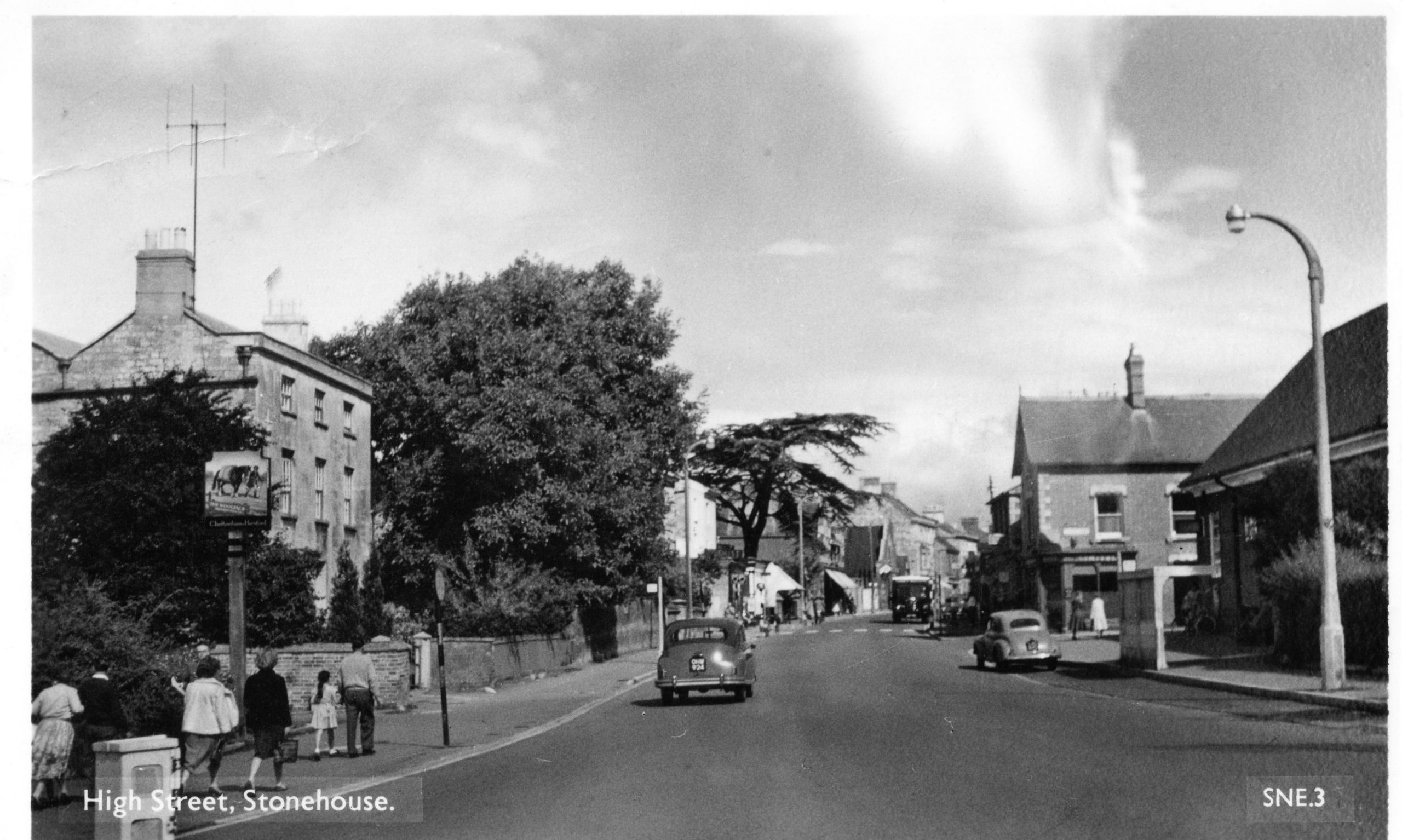
Elgin Lodge on left c1950s
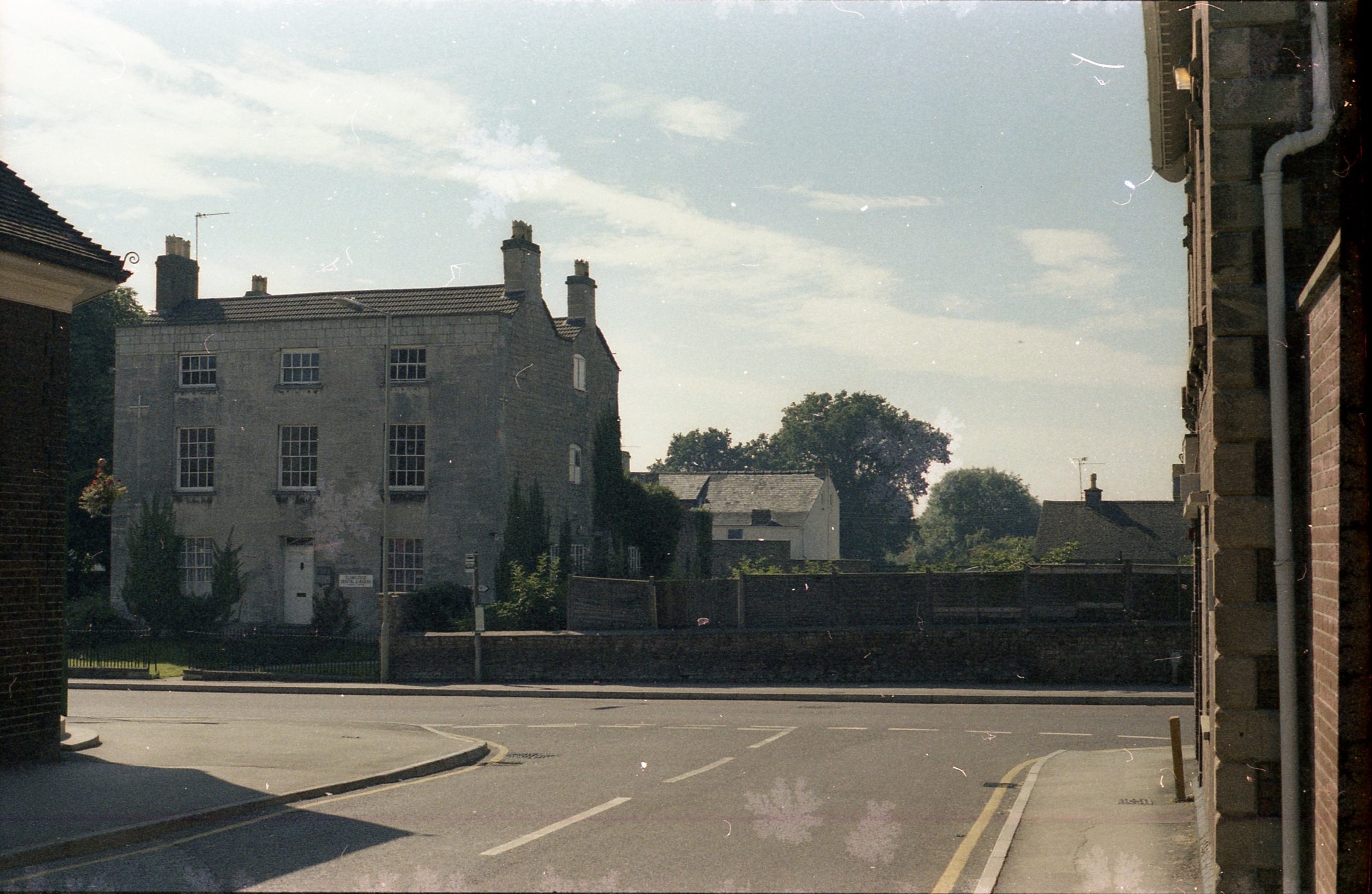
Elgin Lodge August 1987 just before it was demolished
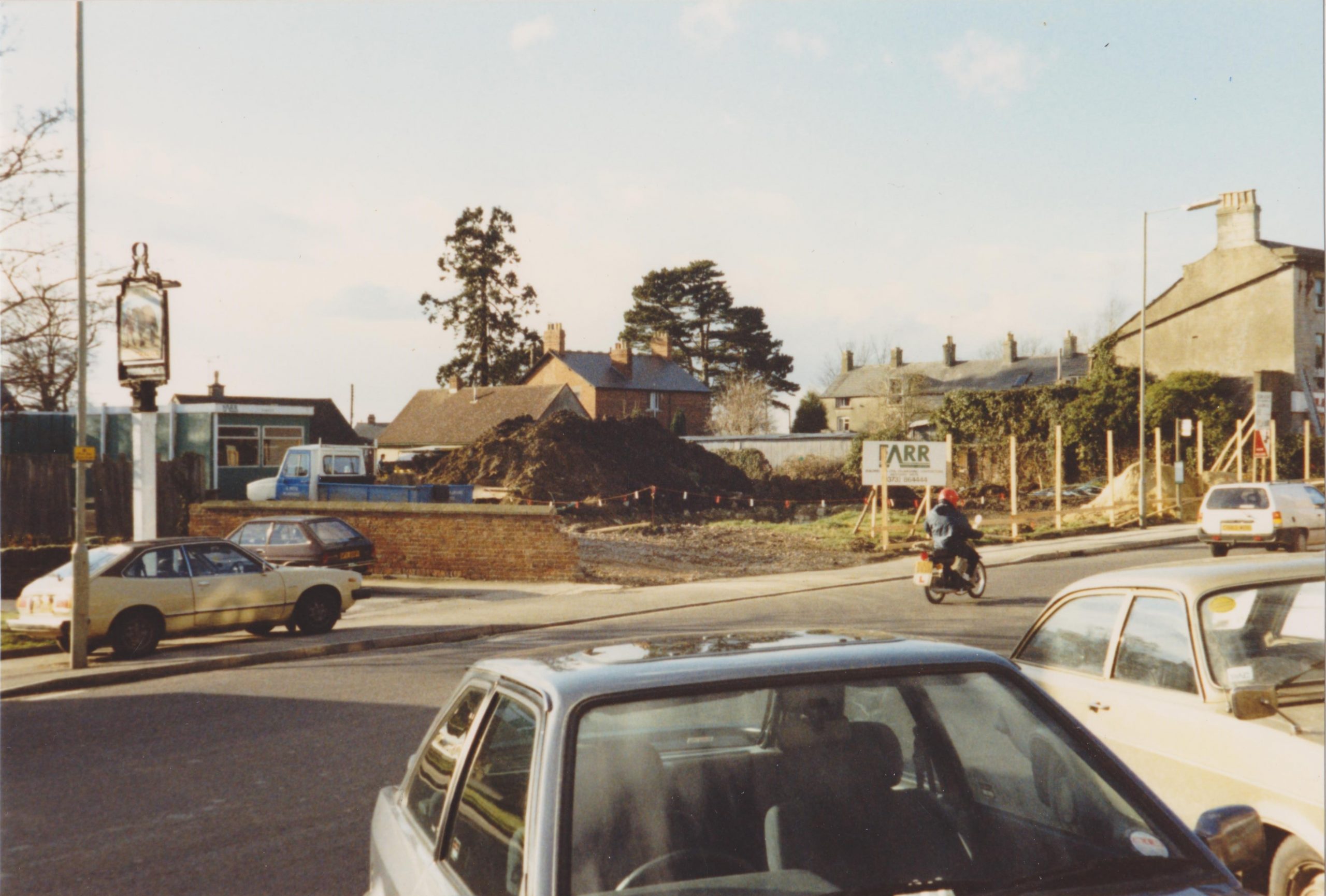
Elgin Lodge demolished
1990
Stonehouse becomes a town.
Population of Stonehouse 6751
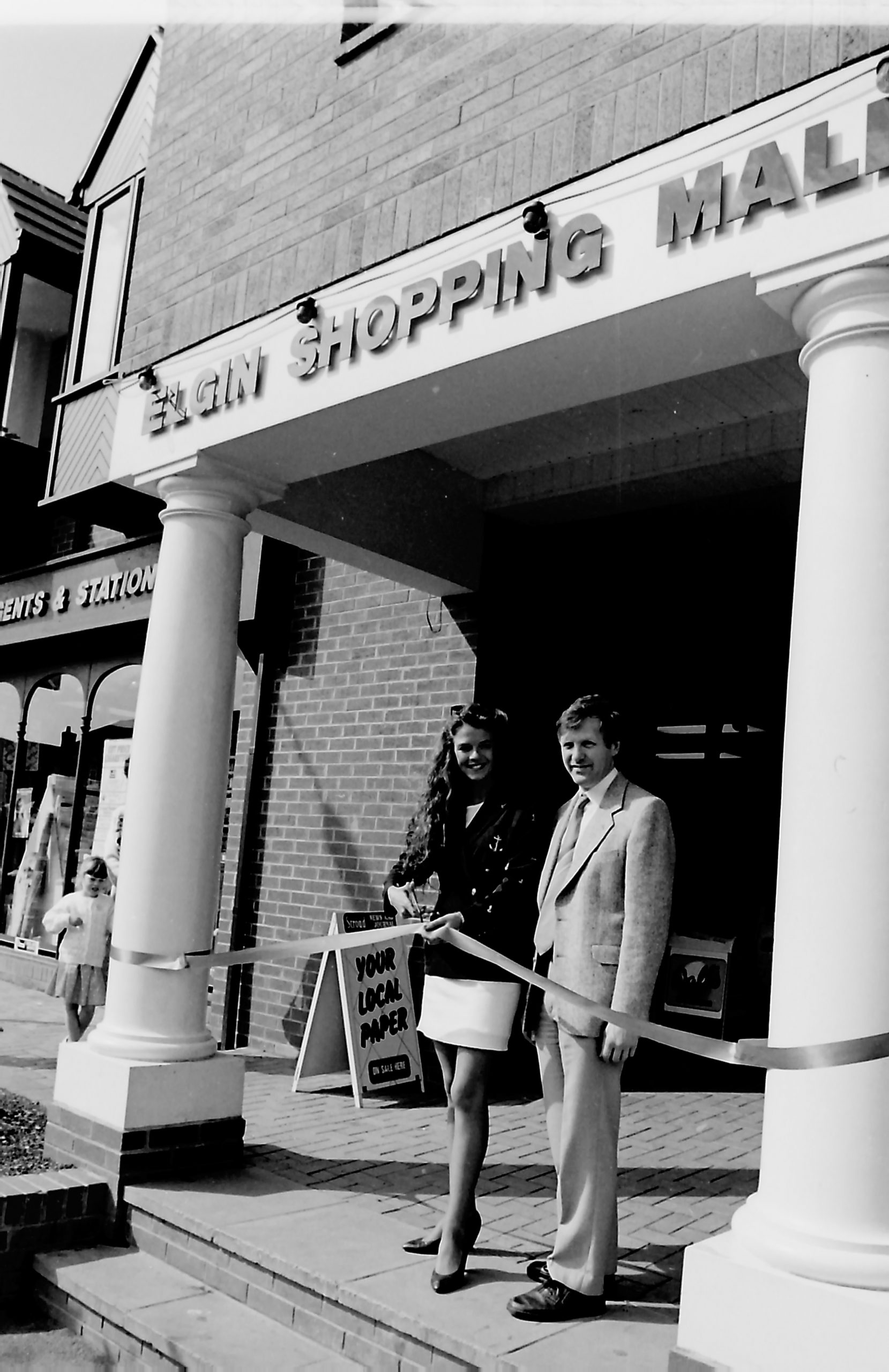
Elgin Mall opened by Annabel Croft and Derek Hurn at Midsummer Madness 1990.
2000
The Millennium Stone was erected in the High Street.
The design represents a doorway from one millennium to the next or from the present to the future; it also recalls the stone house after which Stonehouse is believed to be named. On it are carved symbols of the town and the area using several of the ideas suggested by members of the public during the research phase of the project. Children (or very keen adults) are able to climb through the opening.
Population of Stonehouse approx. 7500
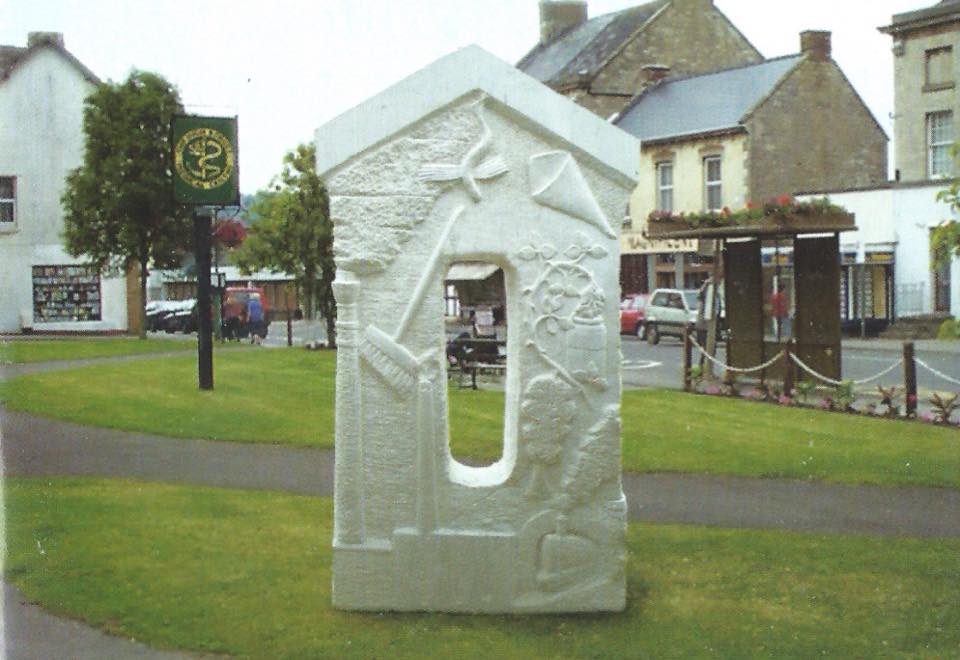
Millennium Stone back
